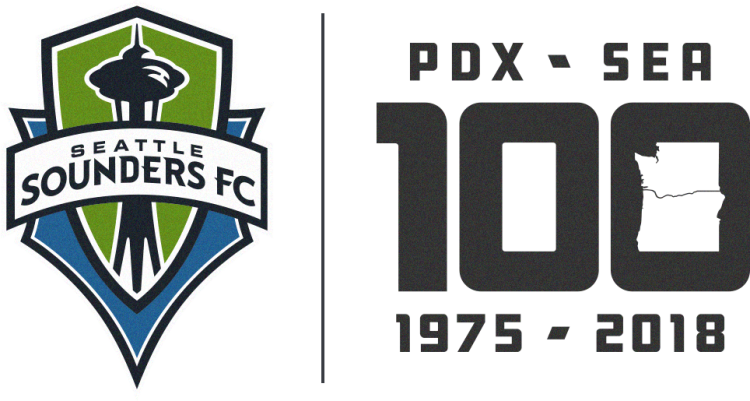SOUNDERS
VS.
TIMBERS
CELEBRATING THE 100TH EDITION OF THE MOST
IMPORTANT SOCCER RIVALRY IN THE U.S.

On May 13, 2018, the Seattle Sounders and Portland Timbers will face off for the 100th time.
Jimmy Gabriel. Tony Betts. Roger Levesque. Caleb Porter. Zach Scott. Timber Jim. The Tree Chop. Rose City. Emerald City. RCTID. EBFG. Forty-three years of battles. Forty-three years of bitterness.
To celebrate the century mark, we’ve compiled the defining moments of the rivalry.
This is Seattle-Portland.
THE EARLY DAYS
NASL AND WSL | 1975 - 1990

May 2, 1975
THE DAWN OF AMERICA'S GREATEST SOCCER RIVALRY
It was spring 1975 in the Pacific Northwest and the rain fell relentlessly at Civic Stadium in Portland. Puddles formed across the playing surface commonly used as a baseball field.
The day was Friday, May 2, and the Portland Timbers were set to play the Seattle Sounders in their inaugural match in the North American Soccer League.
Scottish defender Dave Gillett, who arrived in Seattle via Crewe of England’s fourth division and developed into one of the Sounders’ most consistent performers, recalled the match in Portland.
“That is quite a while ago now, but I do remember a little bit,” said Gillett, who was nicknamed “Chopper” by Sounders teammates for his uncompromising style of play. “[It was] heaving down with rain — not a particularly good field, I think a Triple-A baseball team used to play there. [It was] a little disappointing crowd probably because of the weather. Eight thousand [fans] but I think later in that season they built it up to 25 [thousand], maybe even 30 [thousand], but [it was a] great atmosphere nonetheless.
“And also, I am loathed to say this,” he continued, “but they actually had a pretty good team.”
Another Sounders legend, Jimmy McAlister, was a high school senior in West Seattle when the Timbers and Sounders first met on the pitch in Portland.
“It just grew out of the first year in Portland. We were a second-year team. It grew there, and it’s grown ever since.”
“It was a great game, it was pouring down rain,” said McAlister, who would win the NASL Rookie of the Year award in 1977. “The Portland Timbers grew exponentially that season with each game until the end of the season they were selling out.”
One of McAlister’s heroes, Jimmy Gabriel, tallied the lone goal, a penalty-kick conversion, to lead the Sounders to a 1-0 win.
It was Portland, however, that would enjoy the most success in 1975, finishing the regular season with a 16-6 record and earning a berth in the Soccer Bowl. En route to the Soccer Bowl, the Timbers also knocked off the Sounders in the quarterfinals of the playoffs.
A year after the Sounders entered the NASL, the Timbers had come in and found success on and off the pitch. 1975 would prove to be an accelerator of the Timbers-Sounders rivalry.
“We had established ourselves in ‘74 in Seattle and had done quite well crowd-wise,” said Gillett. “[Portland] had kind of copied Seattle's model: [Go] out into the community, get good young players, play a fast attacking style of soccer and build a crowd out quickly. But they did really well for that first season and that’s what blossomed the rivalry.”
Sure enough, each match between the clubs held at Civic Stadium in 1975 saw an increase in attendance from 7,753 to 27,310 and 31,523 in the overtime thriller in the playoffs.
Soccer had arrived in Portland.
Tim Haag, the Public Relations Director for the Sounders in the mid-1970s and statistician for the club since its inaugural season in MLS in 2009, remembered not knowing what to expect from the Timbers when they joined the NASL.
“It was sort of interesting, we didn’t know what they were going to be like though,” said Haag. “You thought they'd be pretty good because in those days teams were about as good as their pipelines, like connections and what we saw forming in Portland, they looked like they had pretty good connections. They had some very good players that played in the first years.”
Added McAlister: “The guys who played in 1975 really set the tone in this market. The game started before then, but the game started on the professional level with those guys; Jimmy Gabriel, John Best. And Portland has the same guys and they’re still there.
“Not hateful, but close! You know the guy does you in one game and you just remember it. There's still people that if I met I would have a go with them now.”
“It just grew out of the first year in Portland,” he continued. “We were a second-year team. It grew there, and it’s grown ever since. It didn’t start with 30,000 people or a sold-out stadium.”
What began as an unknown commodity on a rainy afternoon in Portland 43 years ago is now the beneficiary of a respect and passion for the game that is visibly abundant throughout North America.
Ambassadors such as the Sounders’ Gabriel, Best, Gillett, Pepe Fernández, Alan Hinton and Brian Schmetzer have carried the torch alongside the Timbers’ Peter Withe, Jimmy Kelly, Tony Betts, John Bain, Mick Hoban and Clive Charles.
The result is two of the proudest soccer cities in North America, hungry to outperform the other on every stage.
“There were very rarely games where one team would beat the other by more than one goal,” said Gillett. “It was always 3-2, 2-1, 1-0, it was always close and intense. That’s the word I would use: an intense rivalry.
“Not hateful, but close! You know the guy does you in one game and you just remember it. There's still people that if I met I would have a go with them now.”
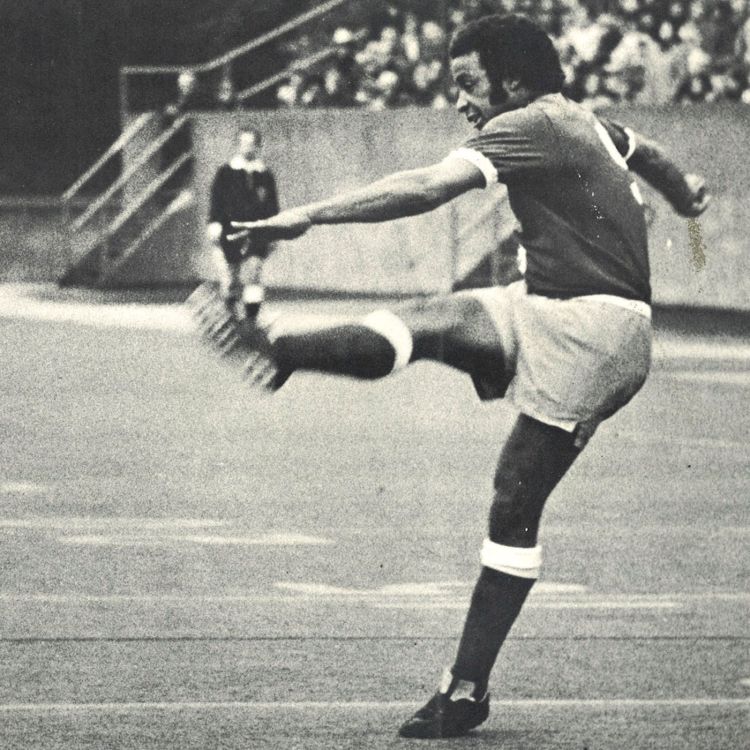
Pepe Fernández, 1975
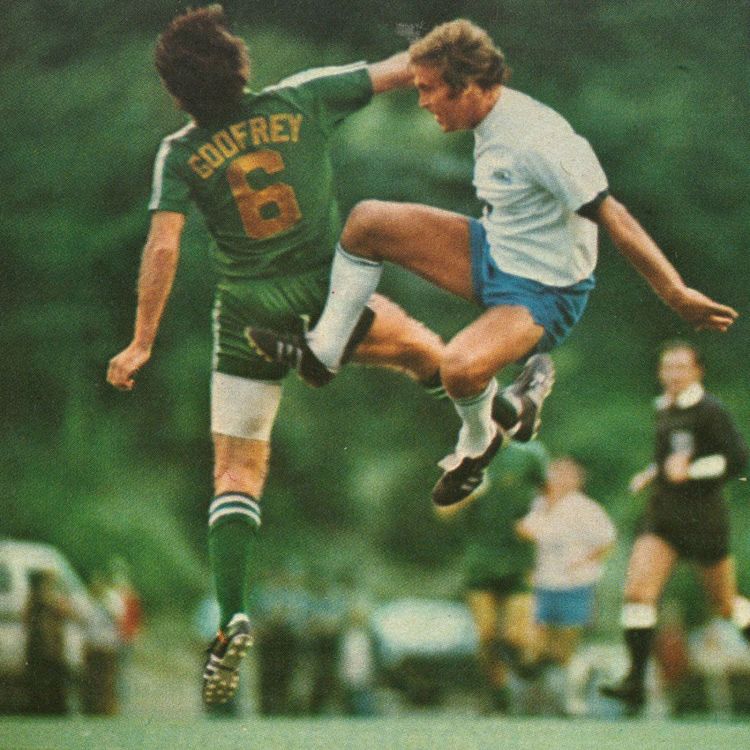
Sounder Tommy Baldwin in action vs. Brian Godfrey, 1975

Dave Gillett, 1975

Memorial Stadium, 1975
June 30, 1979
SoUNDers ROUT timbers 5-1 in front of 34,000 fans at the kingdome
Jimmy McAlister still remembers the call from his mother.
It was 1979 and the former Seattle Sounder had moved on to the Toronto Blizzard, a now-defunct North American Soccer League side. His hometown club had just blown out the Portland Timbers 5-1 in front of 34,000 fans at the Kingdome, still the largest margin of victory between the two clubs in a top professional league in their 40-plus-year existences.
McAlister’s mother was so excited to share the news and knew her son would be proud to hear it. The Seattle native attended the first Seattle-Portland match when he was in high school in 1975 and watched his idol Jimmy Gabriel lead the Sounders to a 1-0 win at Civic Stadium in Portland.
“Everybody was excited and it was really cool [to win by that much], but it just never seems that there’s that much separation,” McAlister said. “There can be separation in the standings, Seattle can be in first place and Portland down the list, or vice versa, but it always seems to be a tough game.”
“‘Soccer City’ in Portland? How is that possible with what we do here [in Seattle]?”
Current Sounders Vice President of Soccer & Sporting Director Chris Henderson remembers Seattle’s early success in the late 1970s fondly. The Edmonds native grew up going to games during his formidable years and wanted to emulate his heroes and their successes in the rivalry.
“I was 10-12 years old, getting serious about soccer,” said Henderson. “Those were the games that were catalysts to, ‘OK, one day I want to be a pro soccer player.’ You could just feel it in the Kingdome, the energy. I just remember there was an extra feeling of tension when you’re at those games that you want to win and support your team.”
The battle for regional supremacy was not lost on either city: the franchises, the players, the fans. The Pacific Northwest was a burgeoning hotbed for American soccer and each city wanted to carry that torch. A massive statement victory five years in would go a long way.
“It’s local bragging rights,” McAlister said. “’Soccer City’ in Portland? How is that possible with what we do here [in Seattle]?
“You want to root for your team, and all the guys who played in it care about who wins,” he continued. “How emotional I can get about Seattle against Minnesota is different than if we play the Timbers and put five on them. It’s always a good laugh.”




A NEW ERA
USL | 2001 - 2008

MAY 11, 2001
A RIVALRY REINCARNATED: AFTER 11-YEAR HIATUS, SOUNDERS, TIMBERS MEET IN USL
After facing off 12 times during the Western Soccer League era from 1985-90, the Seattle Sounders and Portland Timbers rivalry fell dormant as the state of soccer evolved in North America.
The FIFA World Cup and subsequently Major League Soccer entered the soccer landscape in the mid ’90s. The result was a persistent shifting of leagues that were each seeking top-tier status.
The Sounders, following their NASL roots, formed in 1994 as the newest members of the American Professional Soccer League, and after winning the league cup in 1995 and ‘96, joined the USL First Division in ‘97.
“WHEN IT STARTED AGAIN IN THE 2000s, IT WAS RIPE, AND IT HAD MATURED. IT HAD BEEN IN THE OVEN LONG ENOUGH AND IT WAS READY TO EAT.”
“We had started up again in 1994 with the A-League, and that morphed into USL and all the iterations of the league,” said former Sounder and current Head Coach Brian Schmetzer.
But, there was no Timbers.
All that would change at the turn of the century when on May 2, 2001, the Timbers made their USL debut against the Sounders at the recently renovated PGE Park in Portland.
The final result was a 2-0 Portland win in front of 12,295 fans. The Sounders-Timbers rivalry was officially back.
“When it started again in the 2000s, it was ripe, and it had matured,” said University of Portland alum and former Timbers and Sounders defender Wade Webber. “It had been in the oven long enough and it was ready to eat.”
“What I remember about the early 2000s was paying attention — I think I was in St. Louis at the time playing indoor soccer — but you pay attention to your hometown team because I knew a bunch of the guys who were there,” added Schmetzer. “It didn’t really hit me until 2002, with the team, as a coach, but that’s when it struck me.”
The Sounders didn’t qualify for the playoffs in 2001, but the Timbers’ return to professional soccer in ’01 set the stage for USL battles over the next seven years.
THE CASCADIA
CUP IS BORN
2004 - PRESENT

Early 2004
THE CASCADIA CUP IS BORN
“Cascadia” as we know it — the Pacific Northwest region that is connected through ecological, environmental, economic and cultural similarities — was first popularized by a man named Bates McKee in 1972 in his book Cascadia: The Geological Evolution of the Northwest. By the end of the decade, though, the term was also appropriated to describe the three burgeoning soccer clubs within the region: the Seattle Sounders, the Portland Timbers and the Vancouver Whitecaps, and the rivalry that encapsulated it.
For the next 30 years, the three cities prevailed through myriad leagues, players and coaches, but the fan bases maintained a growing resentment toward one another.
When all three clubs joined the United Soccer League in 2004, the fans wanted even more. That March, supporter groups from all three teams — Emerald City Supporters, Timbers Army and Southside Supporters — officially formed the Cascadia Cup, an annual trophy awarded to the team who had the best record against their rivals that season.
“Those three clubs, and those three environments, pour together to be a big rivalry,” said Danny Jackson, who played for the Sounders from 2003-08. “From getting into the stadium and through warmups, you can feel what it means to the fans.”
The three-headed rivalry was already known as the fiercest of the sport in the United States and Canada, but now it had an identity: a two-foot-tall silver cup with a base that inscribed each year’s winner.
The Whitecaps won the first two editions in 2004 and ’05. In 2006, though, the Sounders’ supporters hoisted their trophy for the first time. They did it again in 2007. At the center of the biggest soccer rivalry in the country was this fan-created trophy.
“From getting into the stadium and through warmups, you can feel what it means to the fans.”
“The fans make it. The fans make it everything,” said Seattle native Marcus Hahnemann, who played professionally for 20 seasons, including stints with the Sounders from 1994-96 and 2012-14.
The Sounders’ entrance to Major League Soccer in 2009 ushered in a new era of the rivalry. With the other two teams still in USL, Seattle was left out of the tournament until 2011 when its regional counterparts joined MLS. Once again competing at the highest professional level available, the rivalry echoing throughout Cascadia became the torchbearer for the league.
“Whether it’s modern day on social media or letters to the editor of the local newspaper, you want to be better than those are nearest to you — not much separates the cities,” said S2 Assistant Coach Wade Webber, who played professionally in both Portland and Seattle and in college at the University of Portland. “We’ve put the time in, the miles in. The rivalry has grown where it’s the standard of all MLS rivalries.”
Since 2011, the Sounders have won the Cascadia Cup twice: ’11 and ’15. On both occasions, the Rave Green have claimed the trophy in Vancouver. Although the trophy has yet to be decided in Seattle’s favor at CenturyLink Field in the MLS era, there is undoubtedly a special feeling to invade a rival’s stadium and leave with hardware.
Two years ago today, the Sounders made the journey up to Vancouver...
— Seattle Sounders FC (@SoundersFC) September 19, 2017
We came home with three points and the Cascadia Cup. ⛰️🏆⛰️ pic.twitter.com/FAIE2AqK7a
“The fans have been huge in the rivalry and essentially embody not only what’s [happening] on the field, but also the rivalry between the cities,” said former Sounders forward Roger Levesque.

Kasey Keller hoists the Cascadia Cup in 2011
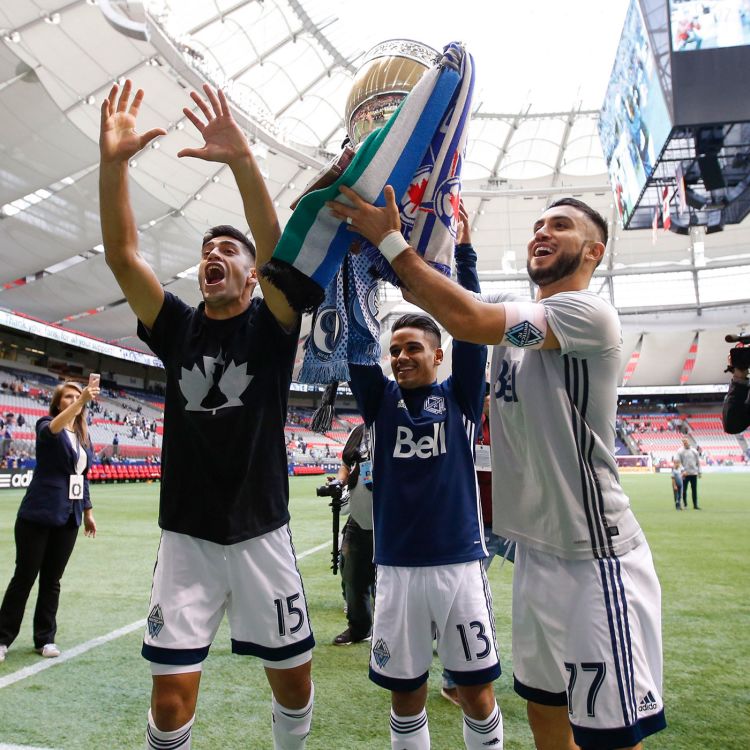
The Vancouver Whitecaps celebrate their Cascadia Cup win in 2016

The Portland Timbers lift the Cascadia Cup in 2017
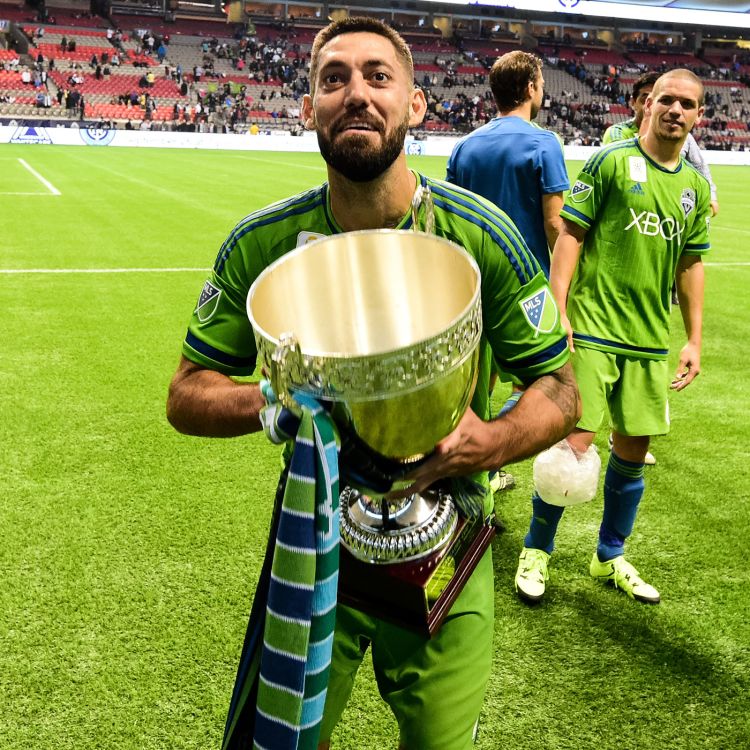
Clint Dempsey celebrates with the Cascadia Cup at BC Place in 2015
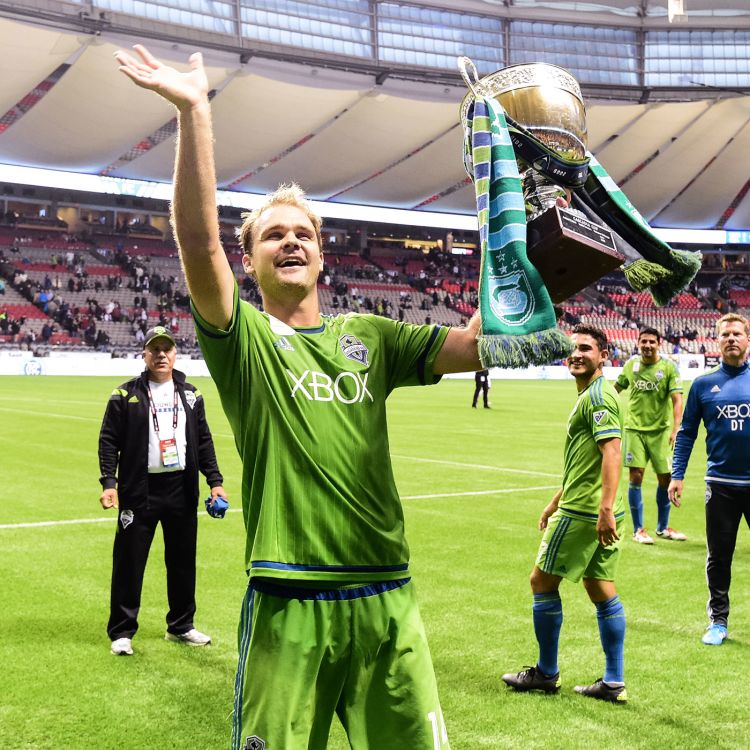
A happy Chad Marshall holds the Cascadia Cup and waves to fans at BC Place
SEPTEMBER 2005
SOUNDERS eliminate timbers ON WAY TO USL CHAMPIONSHIP
Four years before another, more infamous early goal against the Portland Timbers, Seattle Sounders forward Roger Levesque stunned PGE Park with a strike just two minutes into the first leg of their 2005 USL playoff series.
Zach Scott took a long throw in and Levesque was there to head the ball past goalkeeper Josh Saunders to give the Sounders a lead they would never relinquish.
“That [series] was maybe a cog in the wheel or a step in the process of building that strong negative feeling [Timbers fans have toward me],” said Levesque.
In the USL days, the Sounders would always warm up on the Timbers Army side of the field. The fans who were there early would usually heckle the Sounders players as they stretched and took shots on goal. Every time a player missed a shot, the crowd would sarcastically cheer. Levesque wasn’t too fond of that and decided to have a little fun with it.
“I always took opportunities to find ways in warmups to send a ball into the crowd,” Levesque said with a laugh. “I didn’t kick it hard enough to hurt anybody, but it just buzzed them.”
Former defender Taylor Graham is one of Levesque’s best friends dating back to their college days at Stanford. He felt he had a front row seat to Levesque’s antics and how they evolved against Portland.
“His unique character has made it special to watch,” said Graham. “He always finds a way to have success and poke the right buttons.”
The Sounders made sure everybody at PGE Park that day knew who had won. Seattle sings its own version of “Jingle Bells” in the locker room to celebrate every away win, and since the home locker room is so close to the visitor’s, Portland was forced to hear all the cheering and revelry happening next door.
“I always took opportunities to find ways in warmups to send a ball into the crowd.”
“It was the best,” Levesque recalled. “Open up all the doors, sing as loud as you can…the Timbers Army was right out the door too.”
The celebration didn’t stop there. On the three-hour bus ride home, there was singing and beer and jubilation before the Sounders hosted the return leg at Starfire two days later. Levesque would score twice more to seal a 3-0 aggregate victory and confidently lead Seattle into the next round and eventually to its first USL title.
“Portland was one of, if not, the best team in the league that year,” said Levesque. “Maybe we weren’t supposed to win, but we went down there, stole some points and then sealed it up here. Being a part of that championship started to reset the idea of success and what that means to our club and the pride that we take every single time we step on the field.”
OPEN CUP DRAMA
2009 - PRESENT

July 1, 2009
Roger Levesque and the tree chop
If a tree falls in a silent stadium, does it make a sound?
The Seattle Sounders traveled to PGE Park in Portland for the 2009 U.S. Open Cup third-round matchup against the Timbers. Seattle was in its first year in Major League Soccer, while Portland was still in the United Soccer League, two years away from its jump to MLS.
After the Sounders’ bus ride down I-5, they were met by a local father and son by the stadium who watched them unload and head into the stadium for practice. And like father, like son, each flipped off the entire team.
“I just ran over there and was able to get a couple of good chops and he was able to do a good tree fall.”
“[Assistant Coach Brian] Schmetzer loved it,” recalled former defender Taylor Graham. “A father and son can share that moment and say, ‘I flipped the Sounders the bird.’ Schmetzer loves that banter.”
That was nothing compared to what would transpire the following day. During that bus ride, teammates Roger Levesque and Nate Jaqua concocted a plan of how they would celebrate if either one of them scored. Jaqua doesn’t remember whose idea it was, but they didn’t have to wait long to use it.
“There were a lot of different ideas,” said Graham, “and the one they came up with was perfect.”
Not long after the Timbers Army unveiled a tifo of Timber Jim using a chain saw to hack down the Space Needle, just 48 seconds into the match, Sanna Nyassi whipped in a cross that Levesque headed home to give the Sounders the lead.
“The first thing that comes to my mind when I think of this rivalry is Roger.”
What happened next forever solidified Levesque’s place in Timbers hatred and vitriol. Levesque stood stiff while Jaqua mimed an imaginary axe and “chopped” Levesque to the ground.
“The best part is they were trying to get their tifo down and then all of the sudden we score and here comes the tree chop,” said Club Director of Goalkeeping Tom Dutra. “That was the best moment because here they are celebrating the game and we already scored.”
Jaqua said Levesque was a better actor and so he was the one tasked with having to be chopped down, so it worked out well with Levesque being the one to score.
“It just kind of happened,” recalled Jaqua. “I know we talked about it, but a lot of times you talk about a celebration beforehand and it doesn’t work out...I just ran over there and was able to get a couple of good chops and he was able to do a good tree fall.”
Added Levesque: “I think that moment resonated so much because it was so unexpected. Not just me being in the spotlight in that moment and scoring that goal but the timing, 48 seconds in, no one even had a chance to take a breath. The stands were still filling up.”
The Sounders won the match 2-1 to advance to the quarterfinals en route to their first of three consecutive Open Cup titles, leaving a lot of bad blood in the Rose City along the way. Two years later, the Emerald City Supporters unveiled a massive tifo proclaiming a “Decade of Dominance,” a tribute led none other than by Levesque’s immortal 48-second goal, a defining and lasting moment as raw and authentic in a rivalry full of them.
“The first thing that comes to my mind when I think of this rivalry is Roger,” said Graham. “He has been such an interwoven thread throughout the rivalry during my tenure. When I think of Portland, I think of Roger. Those two things are synonymous. I think of his goofy grin, his big beard and the most hated individual [in Portland] and the most liked person in Seattle.”
Added Levesque: “I loved [being the villain], just the irony behind it. Anything I could contribute to just the passion and the growth of the sport and have a little fun with it, I’m gonna be all in.”
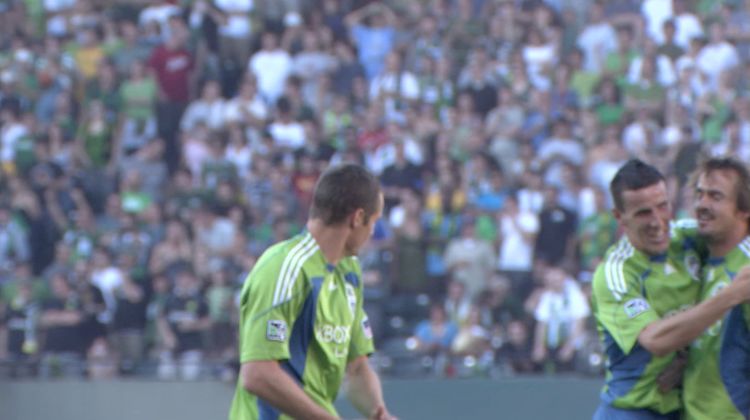

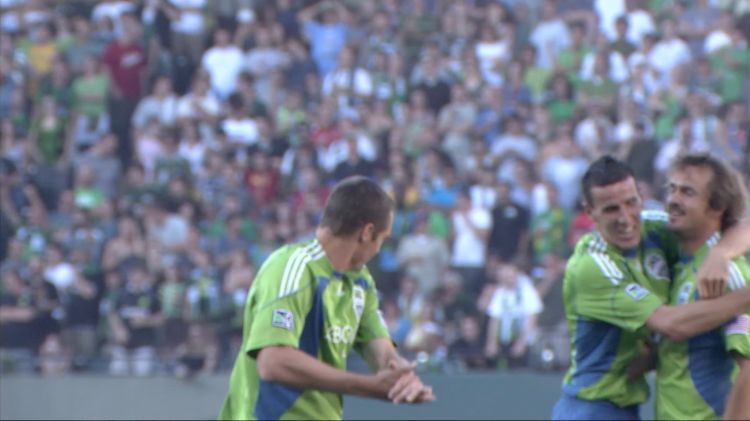

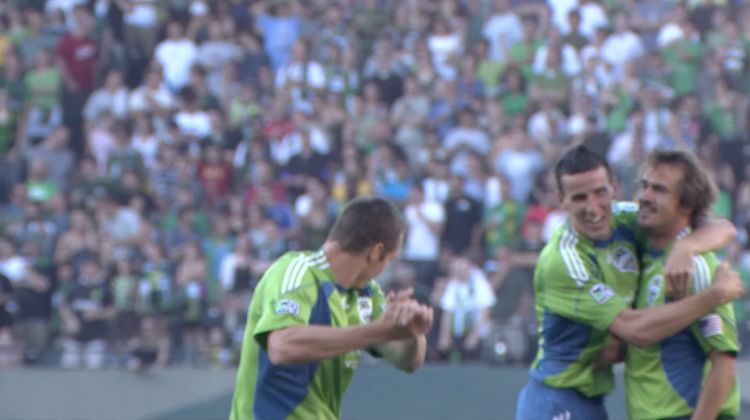
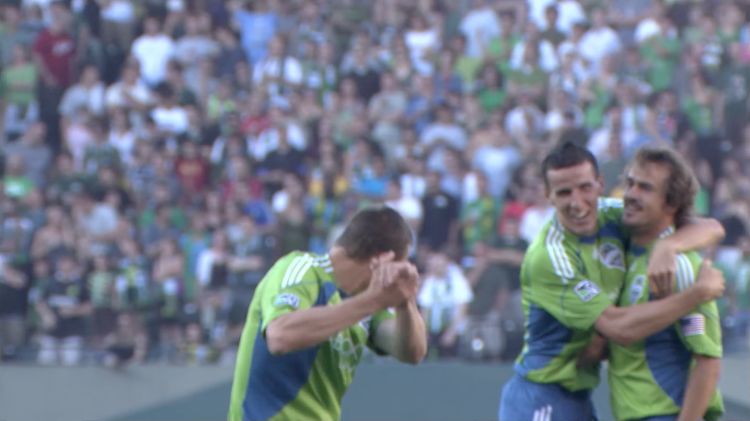
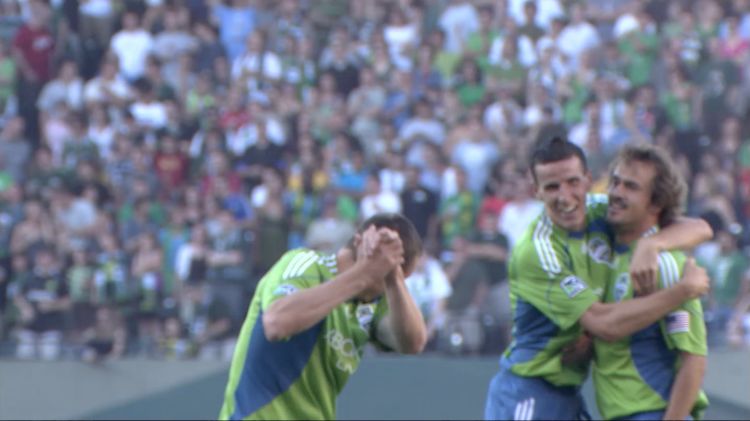
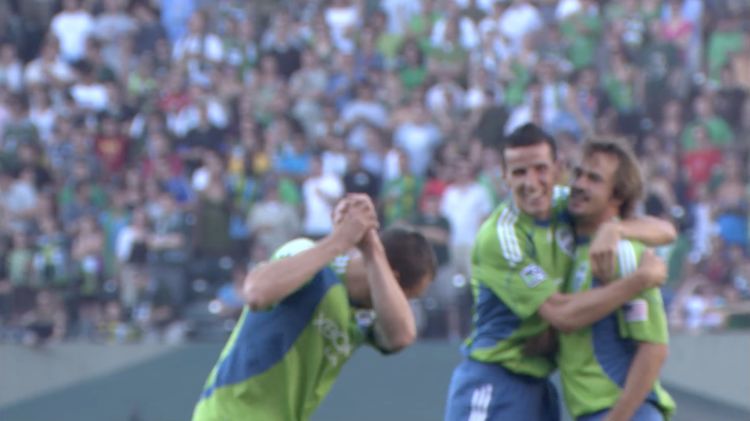

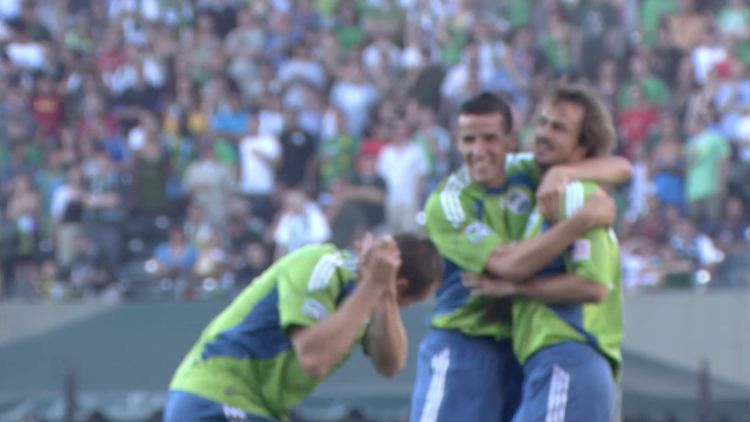
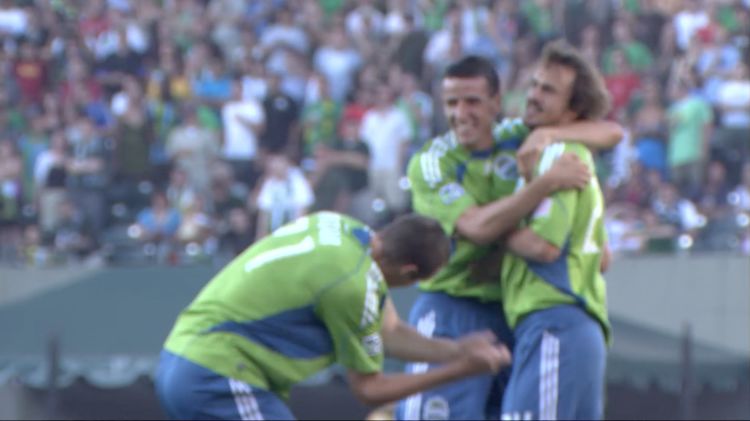
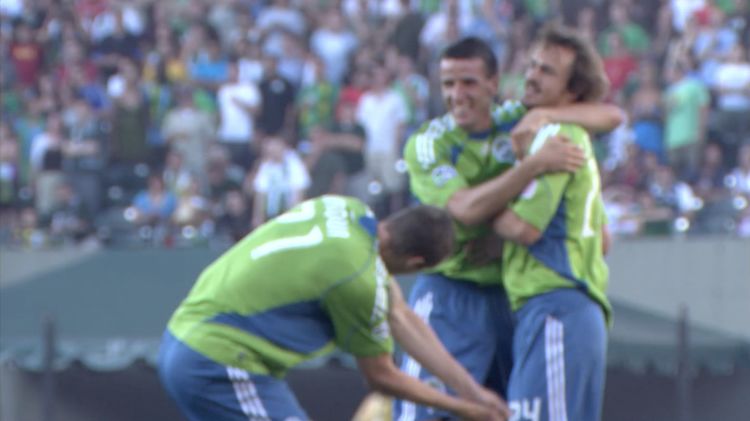
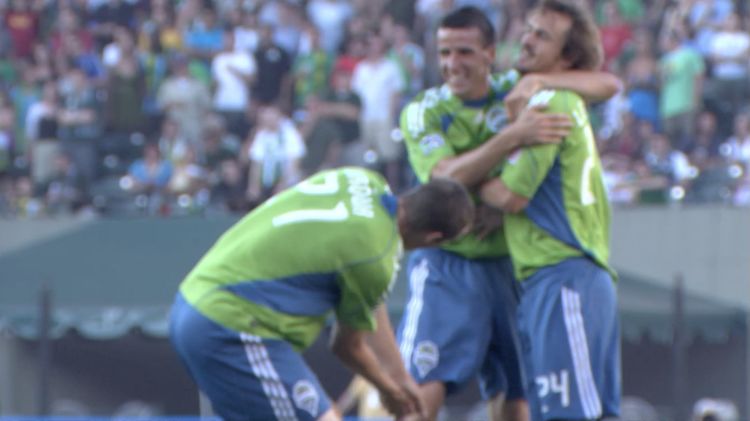
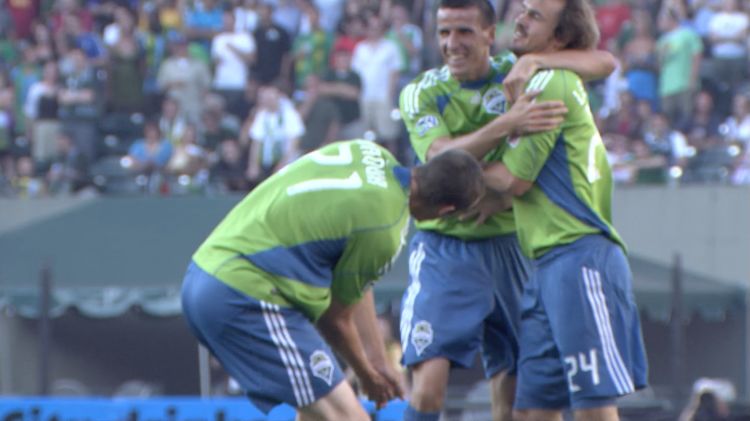
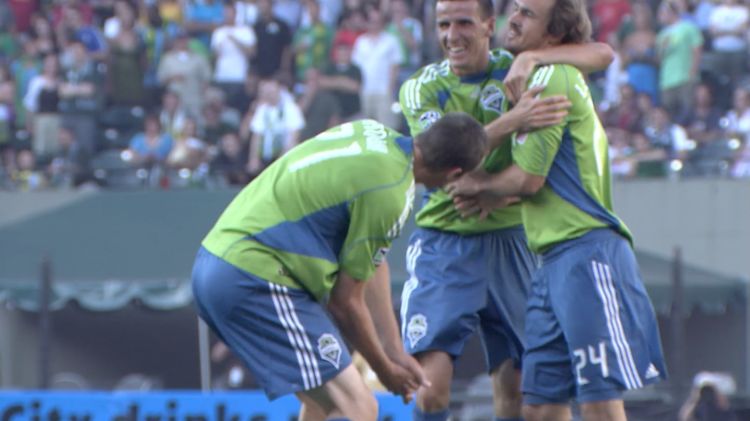
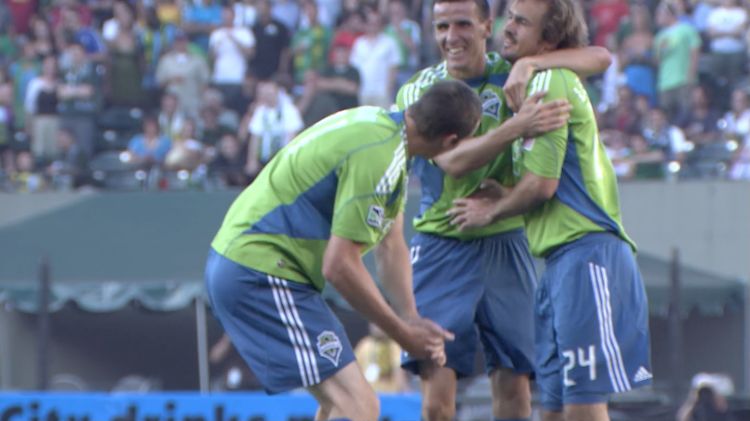
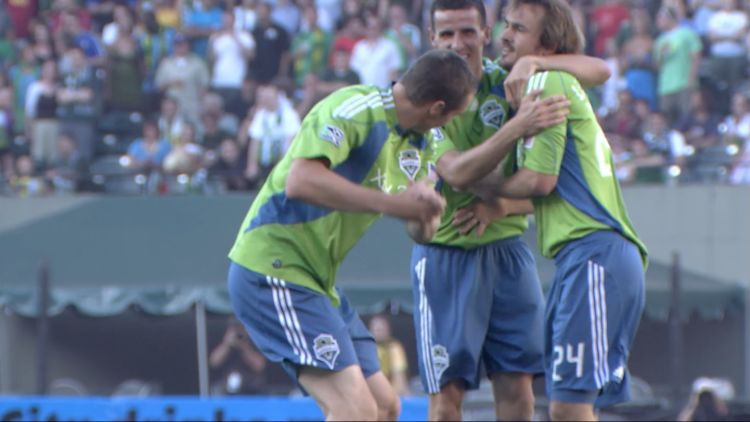
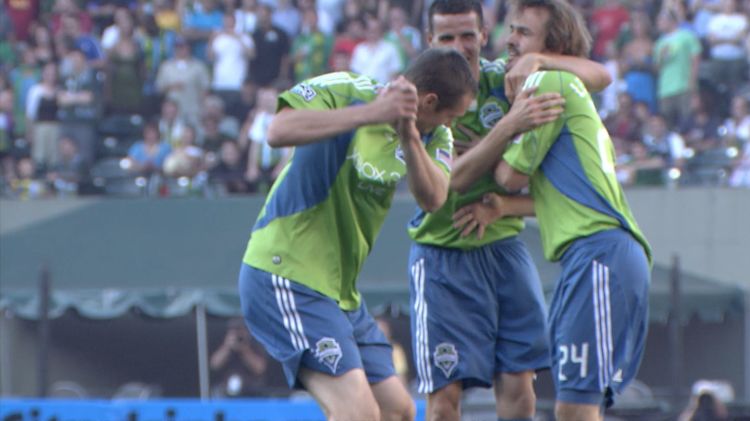
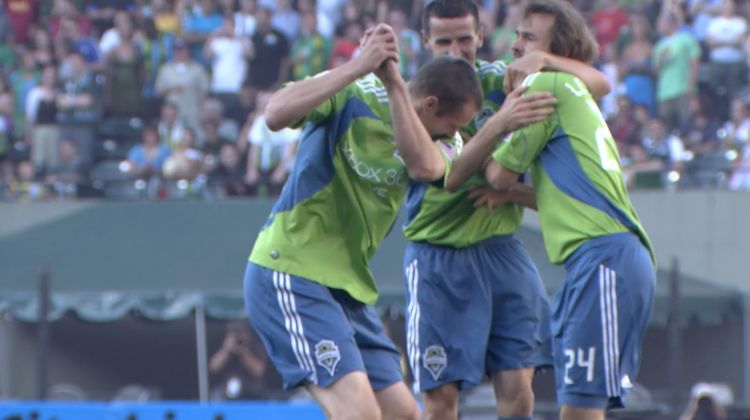
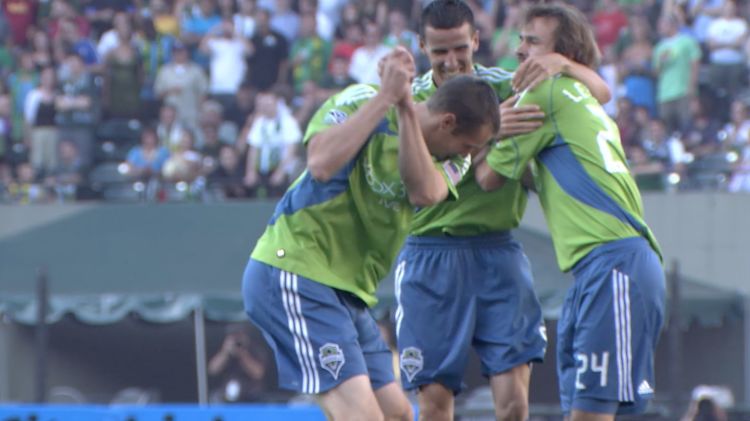

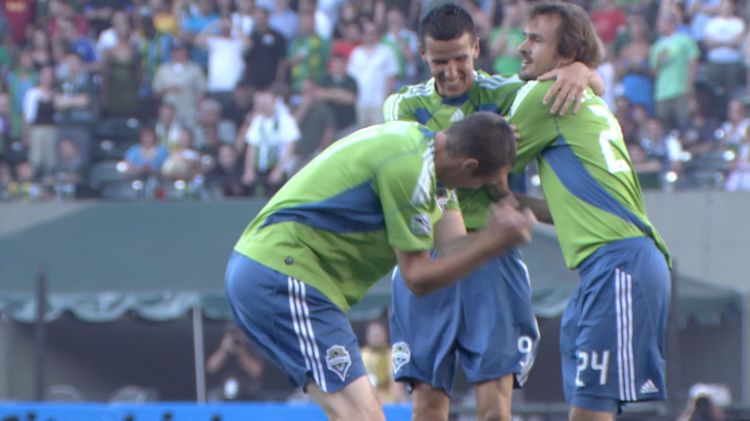
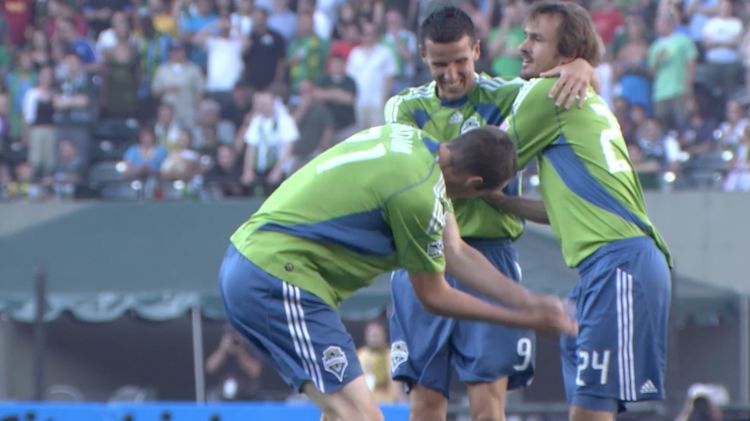
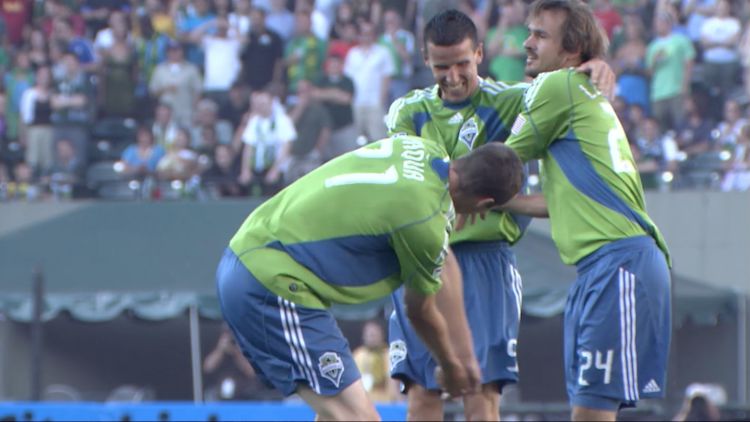
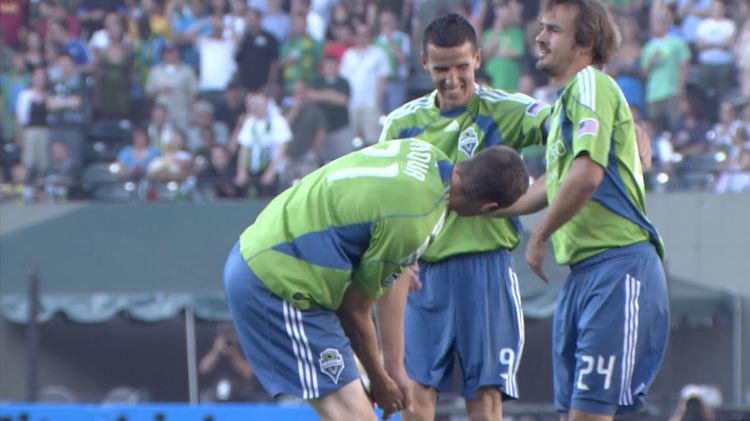
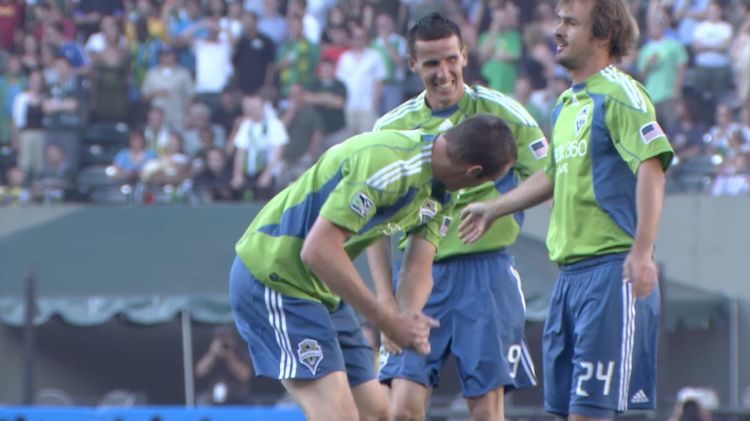
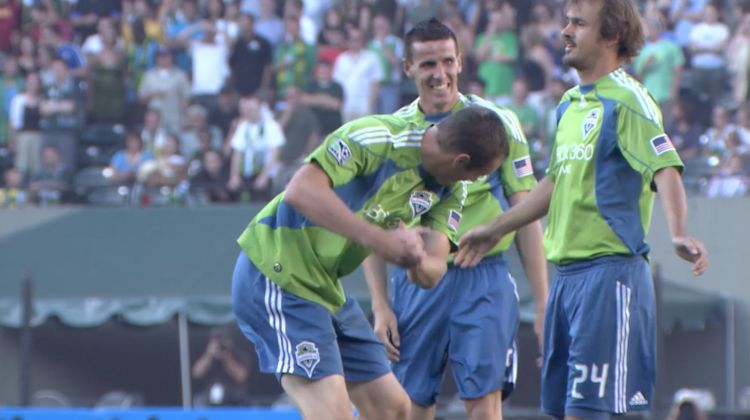

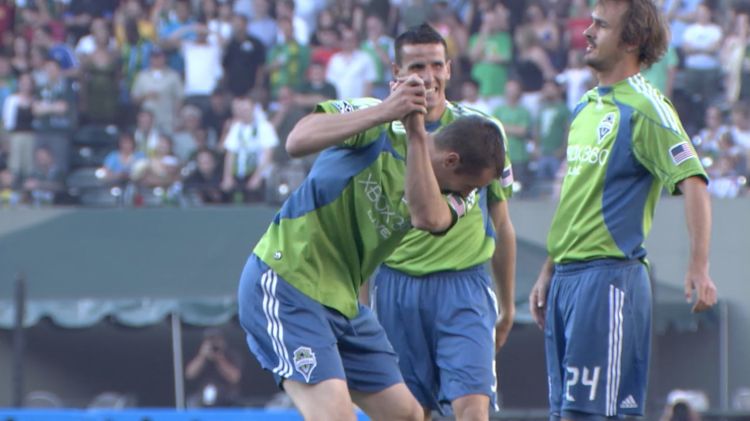

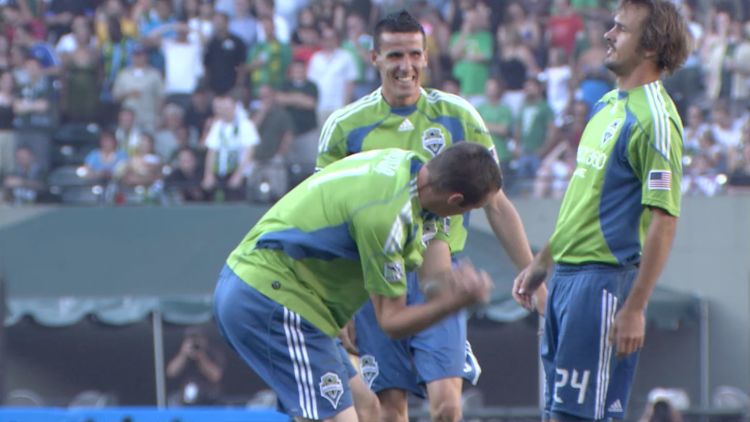
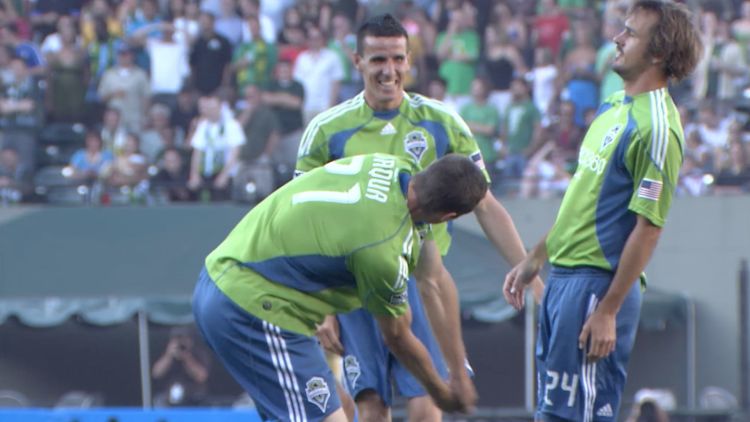

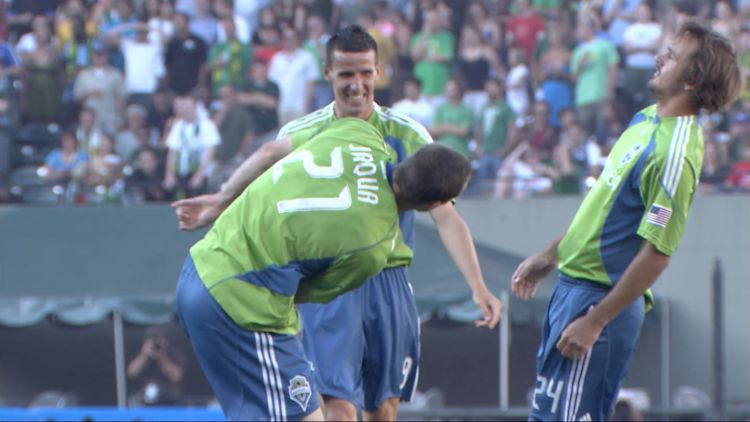
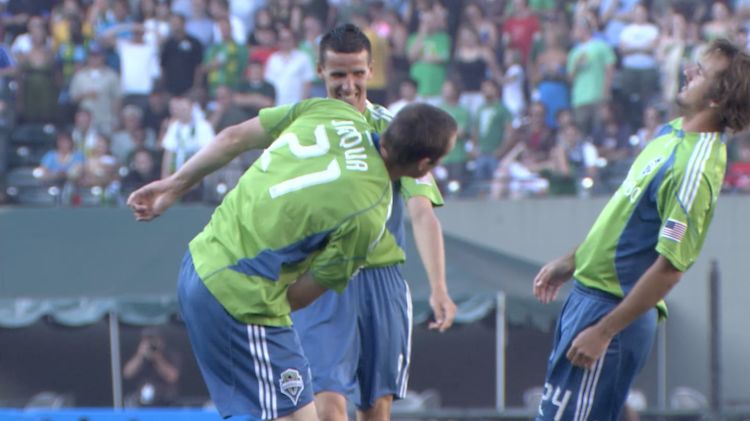
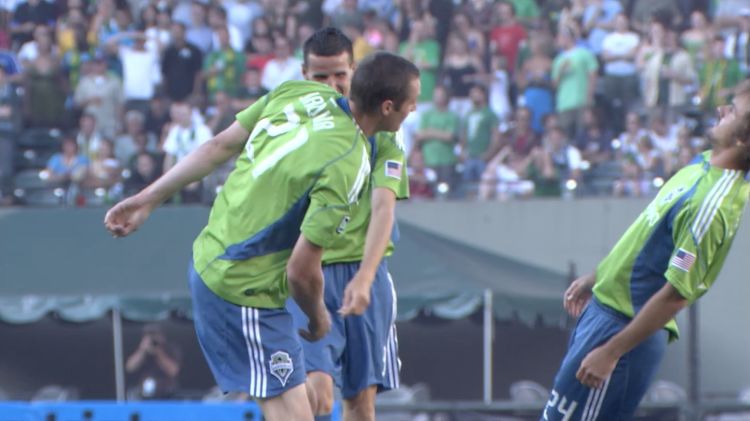



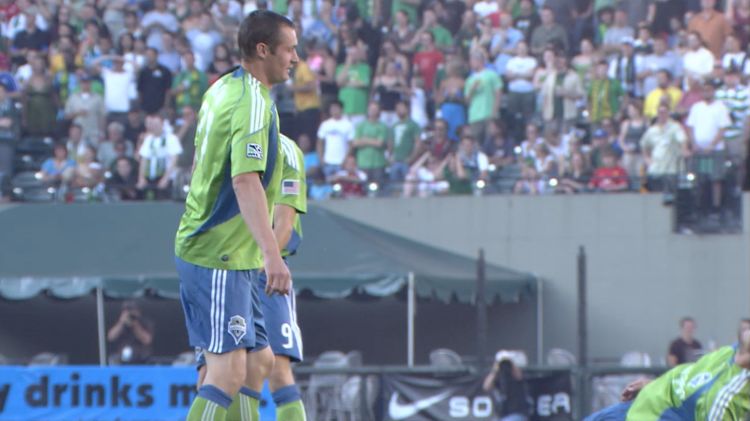
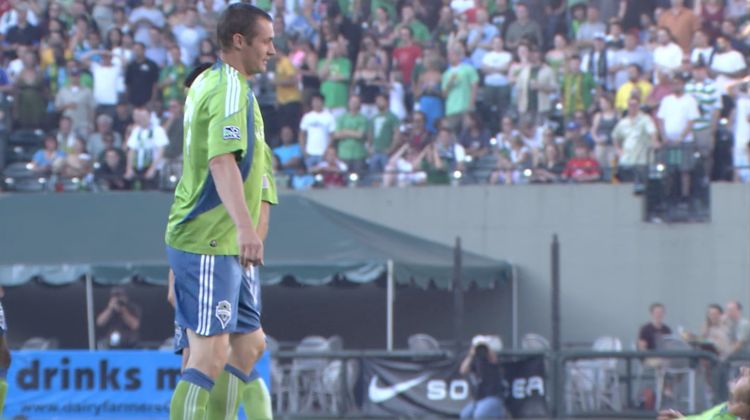
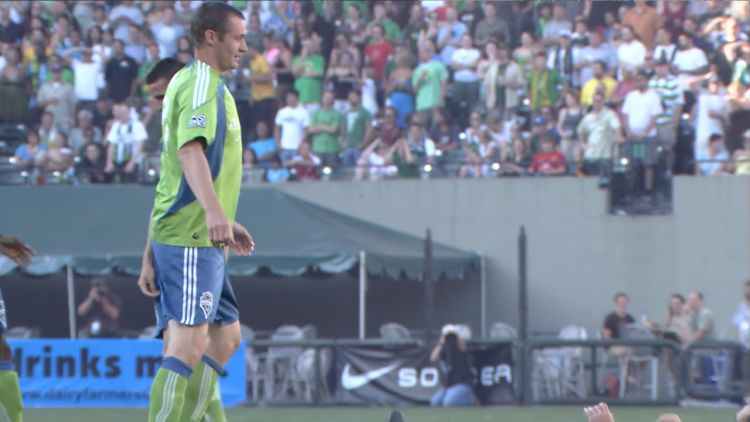
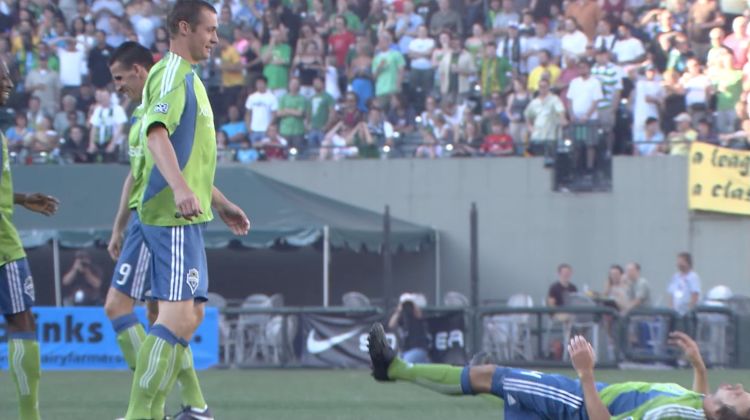

June 30, 2010
Sounders beat timbers in penalty kicks in 2010 u.s. open cup
When the Seattle Sounders waltzed into PGE Park on June 30, 2010, in the third round of the U.S. Open Cup, the memories of the year before lingered deeply, angrily, throughout the city of Portland. Nate Jaqua had chopped down Roger Levesque, the Sounders escaped 2-1 winners and went on to win their first Open Cup title.
Fast forward a year and the Timbers, in their final season in the USL, had the chance for redemption for which they had been waiting. They had an opportunity to knock off Seattle and dethrone the reigning champions.
“You have Seattle as the big brother and Portland always trying to catch up,” said Levesque. “That would have been one that I don’t think they’d ever let us forget.”
Former Head Coach Sigi Schmid usually led the pregame speeches, but he notably deferred to Assistant Coach Brian Schmetzer, a Seattle native and former Sounders player and USL coach, to get his team ready. He did not disappoint.
“I’ve seen movies like Gladiator,” said former winger Steve Zakuani. “I’ve seen Coach Carter. This was one of the best speeches. I was ready to run through a wall. Schmetzer got so emotional and it was all about letting us know what it meant to be from Seattle and what this game meant.”
“The one thing I do know is that [Scott] was the right person to step up in that moment against Portland with a lot of pride on the line.”
Added Schmetzer, deferring: “That game won’t be remembered because of any speech that the coaches gave, it will be remembered because 18 Sounders went down there under adverse circumstances in a massive game and Zach Scott scored the [game-winning] penalty.”
Jaqua opened the scoring for the Sounders in the 13th minute before Bright Dike leveled the match in the 38th. The teams remained deadlocked and fought through two periods of extra time, but still couldn’t find a winner. The match went into a penalty kick shootout, and Scott stepped up with a chance to win the game and send the Sounders to the quarterfinals.
Coolly, calmly, he buried his shot into the right side of the goal and turned and awaited his onrushing teammates.
“The one thing I do know is that [Scott] was the right person to step up in that moment against Portland with a lot of pride on the line,” said Levesque. “Maybe it’s in the history books now that both teams are in MLS, but Zach doing the job that he needed to do, which he had done for the Sounders organization I don’t know how many times across I don’t know how many years, cements his standing in the rivalry, there’s no question about it.”
The Sounders silenced Portland yet again on its home field and for the second straight year captured the Open Cup championship. What was already rich was made even sweeter knowing Seattle knocked off Portland in the process.
“If you lose to Portland, it’s a scar that lasts more than just the week until your next match,” said former Sounders defender Taylor Graham. “The feeling of hating to lose against Portland completely outweighs every other loss that you have. That’s what Schmetz was able to instill in us: if you hate to lose, you hate to lose to Portland, and it could potentially change the trajectory of the emotional state of your team.”



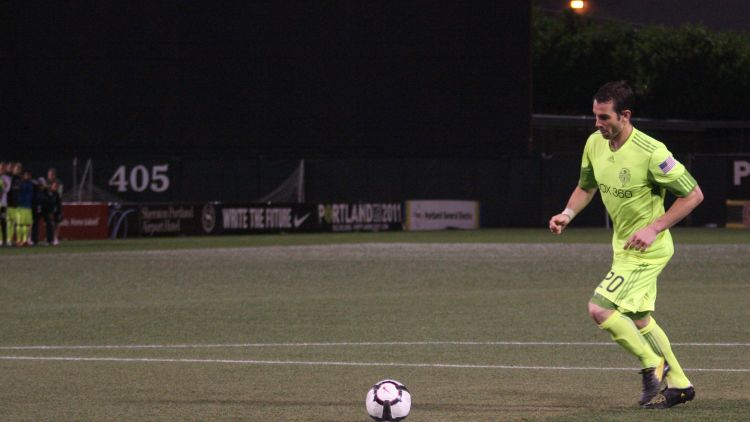

June 16, 2015
a dark night at starfire
On June 16, 2015, the Sounders entered their Lamar Hunt U.S. Open Cup match with a perfect 19-0-1 record at Starfire Stadium.
By the end of the night, the unbeaten streak was broken, the Sounders finished with seven players on the field and a police escort guided the referees off the pitch in a match that would become colloquially known as “The Red Card Wedding.”
Add in a jersey switch at halftime, a star player leaving the match on a stretcher, a shredded referee notebook and a coach who voluntarily removed himself from the sidelines, and it is, undoubtedly, the most chaotic, absurd and bewildering match in the Sounders-Timbers rivalry.
“We, in that game, shot ourselves in the foot,” reflected Brian Schmetzer, who was then a Sounders Assistant Coach. “It’s a dark chapter, but it highlights the raw emotion of the teams.”
The match started out seemingly normal, with a high-energy crowd of over 4,000 fans packed into Starfire Stadium. At halftime, though, things started to get a little weird. The Sounders had played in their black kits, while the Timbers came to Seattle in their dark green. As summer darkness crept onto the field, the Sounders entered the second half with a kit change — a unique combination of white shirts and bright green shorts.
“That stark color change was nowhere near as stark as the explosion in play that would follow,” wrote Ryan Cowper on SB Nation blog Sounder at Heart.
“I have never, ever seen a finish like this in my life.”
Portland’s Diego Valeri opened the scoring in the 49th minute, and then the Sounders received another blow 20 minutes later when captain Brad Evans recorded his second yellow card. Down a man and down a goal, the Sounders brought on Clint Dempsey to find the equalizer. In the 79th minute, Obafemi Martins would knock home a goal to even the score at 1-1.
However, moments before the end of regulation, Martins had to be stretchered off the field with a groin injury. With all three subs already used, the Sounders were down to nine men.
“For me, the worst part about that game was Oba’s injury, and that sometimes gets overlooked with all the other stuff,” said Team Administrator Grant Clark.
One hundred minutes into the match and with a two-man advantage, Portland’s Rodney Wallace gave the Timbers a 2-1 lead. The emotions of those on the pitch and the restlessness in the stands became tangible.
Two minutes later, Sounders midfielder Micheal Azira was given a straight red card for an errant elbow. In defense of his teammate, Dempsey approached referee Daniel Radford and knocked the notebook from his hands. He then picked it up and tore it to shreds, signaling his displeasure at the referee’s decision.
For that, Dempsey was also given a red card. Three ejections, one injury. The Sounders were down to seven men.
“The final few minutes is ending in absolute chaos,” bellowed Ross Fletcher on the broadcast. “I have never, ever seen a finish like this in my life.”
In the heat of the moment, Head Coach Sigi Schmid removed himself from the sideline and watched the remainder of the match from the far corner of the field.
“I didn’t want to get thrown out, so I just walked away from the bench,” Schmid would later tell media. “I figured I should walk away before I did something stupid.”
Portland went on to add another goal in the last few minutes for the final 3-1 scoreline. A string of boos echoed from the stands as police escorted the officials off the field.
It was difficult for the Sounders to rebound from the repercussions of this fiasco. Over the next 11 matches, Seattle lost nine and eventually fell in the Western Conference Semifinals. Portland, meanwhile, went on to win its first MLS Cup.
“The game unraveled…” wrote Matt Pentz of The Seattle Times. “Rarely has the rivalry ever been so visceral.”


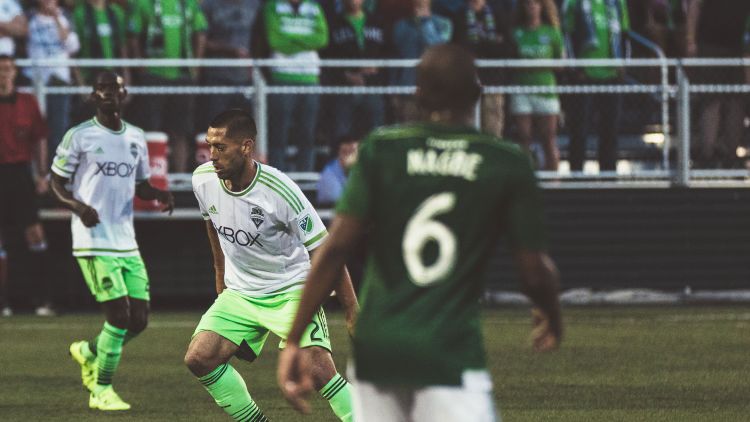
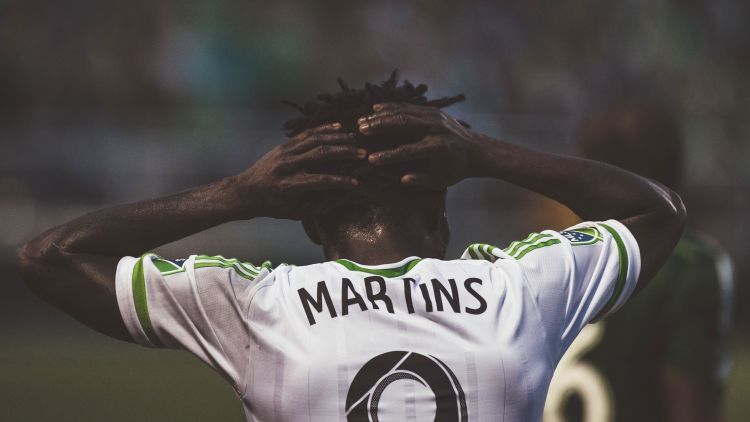

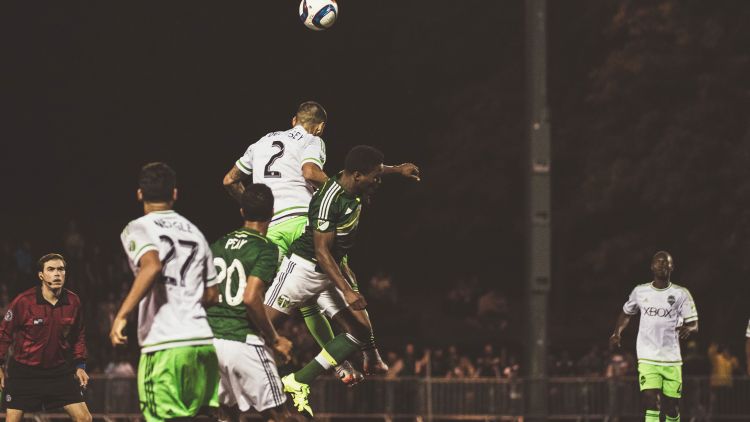

THE RIVALRY
COMES TO MLS
2009 - PRESENT

March 2011
SOCCER CITY, USA - PORTLAND OR SEATTLE?
The billboard stood confidently along 4th Avenue with the Seattle city skyline in the background. The Timbers’ foray into Major League Soccer was just months away and they weren’t going to be taken lightly by their big brother to the North.
Timbers Chief Operating Officer Mike Golub explained the thought-process behind the billboard.
“We knew that the rivalry was going to be taken to a new height with us joining the Sounders in MLS,” explained Golub.
“We knew that our respective supporters have a lot of fun with each other and we thought that we’d have a little fun with their front office by planting a flag, if you will, on their home turf.”
“Portland always wants to be Seattle, there’s no question about it.”
In 2016, The Oregonian conducted a study attempting to get to the bottom of which city was the true Soccer City, USA. Sixteen U.S. cities with MLS teams were compared and based on their performance in 10 different categories, and the Seattle Sounders came out on top.
Said Timbers owner Merritt Paulson to The Oregonian: “It wasn't too long ago that there weren't many cities that wanted to be called Soccer City, USA. I think the fact that there are people arguing over that title shows how far the sport has come.”
Seattle native and Sounders legend Jimmy McAlister was a student at John F. Kennedy High School when the Sounders and Timbers first took the field together. To him, there’s only one Soccer City, USA.
“Portland always wants to be Seattle, there’s no question about it,” said McAlister. “Portland will never be Seattle. They want to call themselves “Soccer City” and this and that, but there’s only one Soccer City on the West Coast, and that’s Seattle.”
Aug. 25, 2013
WELCOME TO SEATTLE, DEUCE!
In hindsight, it simply had to be against Portland.
When Clint Dempsey — Deuce, Captain America and perhaps the most successful American field player to ever compete in Europe — made his Sounders home debut in August 2013, he did so against the club’s biggest rival. In front of the highest-attended match in club history (67,385), Dempsey played a full 90 minutes to lift Seattle to a 1-0 victory.
“I think, as I have been here longer, I have more of an appreciation for it,” reflected Dempsey. “It takes a little while to feel that rivalry because everything is so new, but now it’s definitely more special to play in those games because of the history, the stories you hear and making your own history.”
Dempsey’s home debut came after a few weeks of heavy anticipation. On Aug. 3, Dempsey was introduced in a Sounders jersey prior to a match against FC Dallas. After a pair of road matches against Toronto and Houston, Dempsey played at CenturyLink Field for the first time. The atmosphere was unforgettable.
“It was quite simply a hot-blooded soccer paradise on Sunday, with the teeming mass of humanity packed into CenturyLink Field intent on showing Clint Dempsey that his instincts were right,” wrote Larry Stone of The Seattle Times. “That the soccer passion here was indeed tangible. That the emotion was palpable. That there was no better place to practice his craft than a football stadium in Seattle on an overcast August evening.”
At the prime age of 30, Dempsey’s decision to join MLS had a massive impact on the sport in the United States. He was coming off a seven-goal campaign with Tottenham of the English Premier League, where he stacked up against the top class in Europe. From 2007-12, Dempsey starred for Fulham, recording 50 tallies in nearly 200 appearances.
A few months earlier, he had been named captain of the U.S. men's national team ahead of the FIFA World Cup that would take place the following summer. For a league that had been known as a destination for top talents at the end of their careers, signing Dempsey gave the Sounders’ organization notable credibility.
“Any time you can have bragging rights and play for the city, there is always more incentive.”
“For those in the Northwest, soccer consists of billowing smoke, rabid supporters and packed stadiums. And now, Clint Dempsey, as well,” wrote Josh Liebeskind of The New York Times.
The game’s best always shine when the lights are the brightest, and Dempsey is no exception. In the five years since his team debut, Dempsey has proven to be a one-man wrecking ball against Portland, scoring nine goals in 10 career matchups. He’s recorded a hat trick, scored a last-second equalizer and was, infamously, given a red card for his antics in the fourth round of a chaotic Lamar Hunt U.S. Open Cup match.
Deuce never says die. #PORvSEA pic.twitter.com/eBAtCgo81d
— Seattle Sounders FC (@SoundersFC) June 26, 2017
“It’s always exciting to play against them,” Dempsey said. “It’s a rivalry game. It’s huge for the city…I just like playing in big games. Any time you can have bragging rights and play for the city, there is always more incentive.”

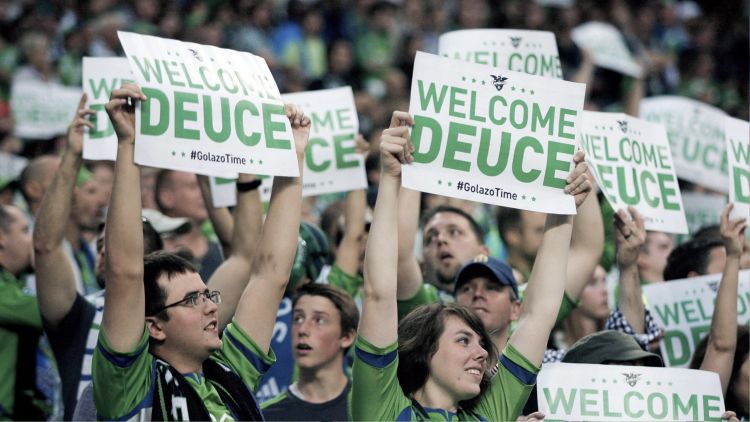

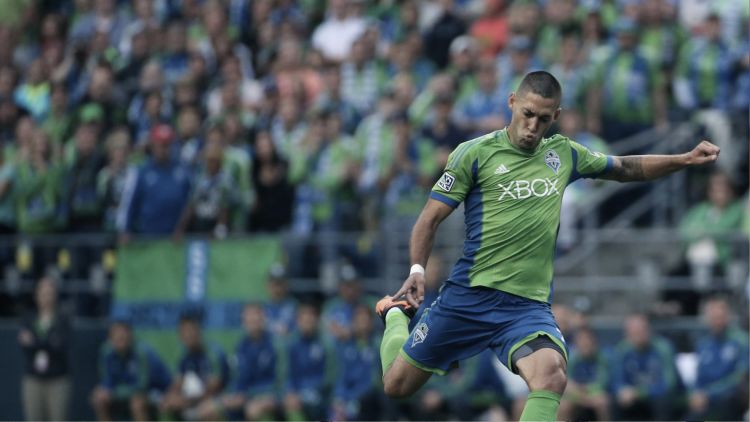
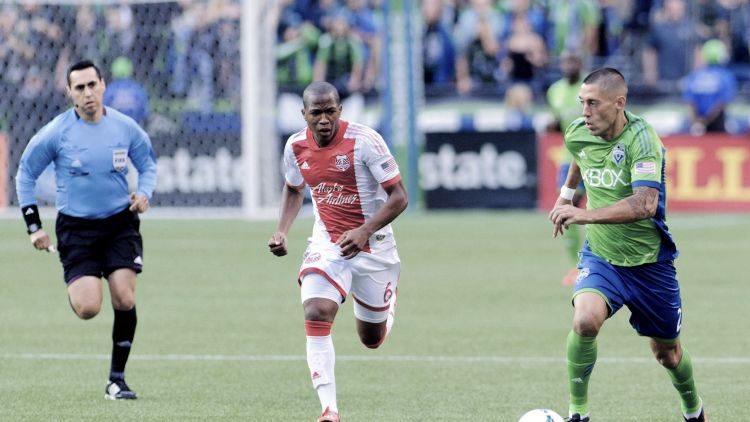
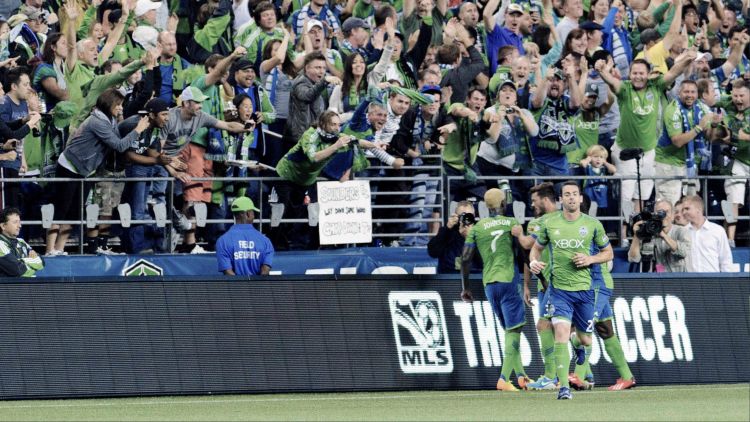

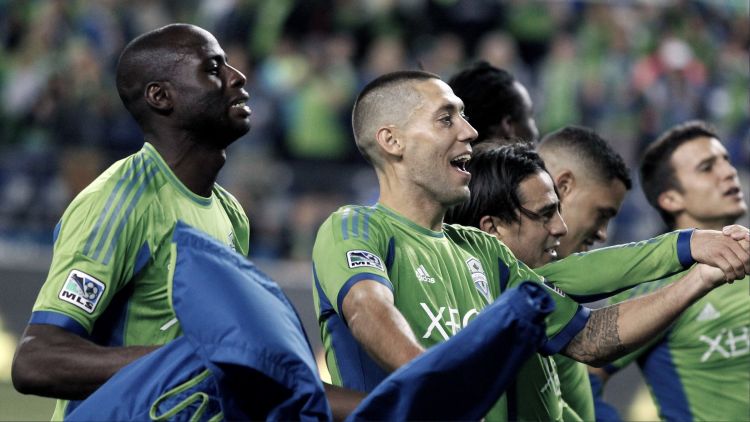
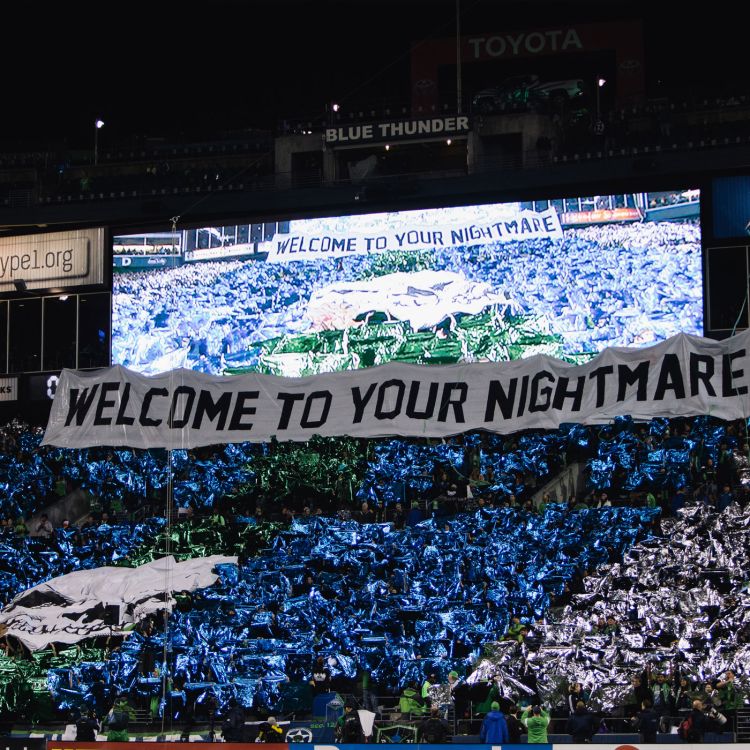
ECS unveils a tifo prior to the first leg of the 2013 Western Conference Semifinals
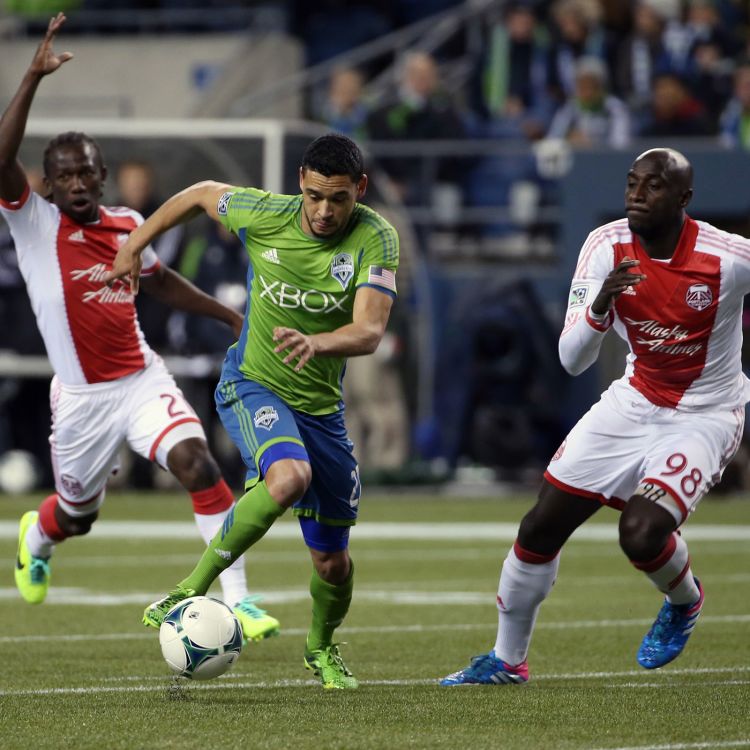
Lamar Neagle dribbles against the Timbers at CenturyLink Field

Osvaldo Alonso celebrates after scoring in the first leg

Sounders fans at JELD-WEN Field during the second leg
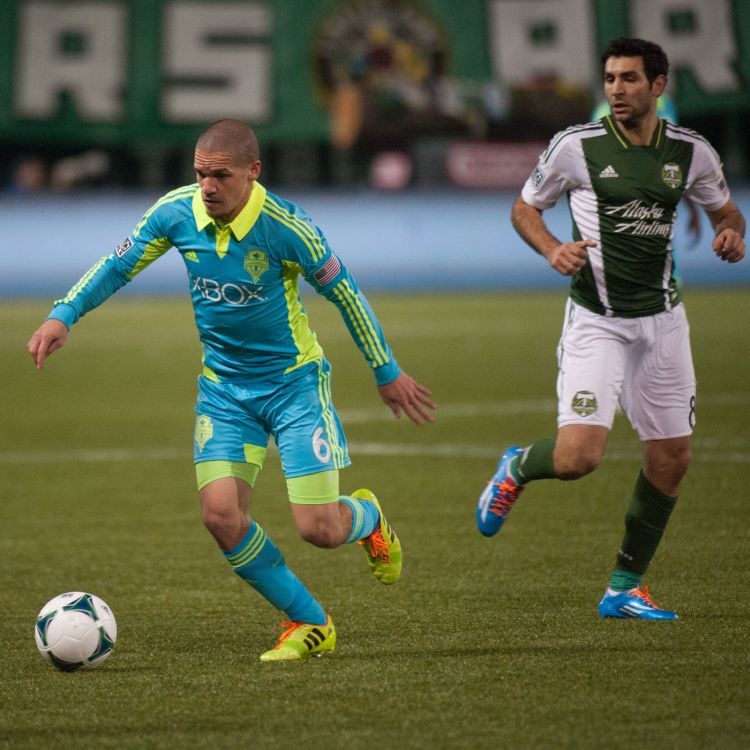
Osvaldo Alonso dribbles past Diego Valeri
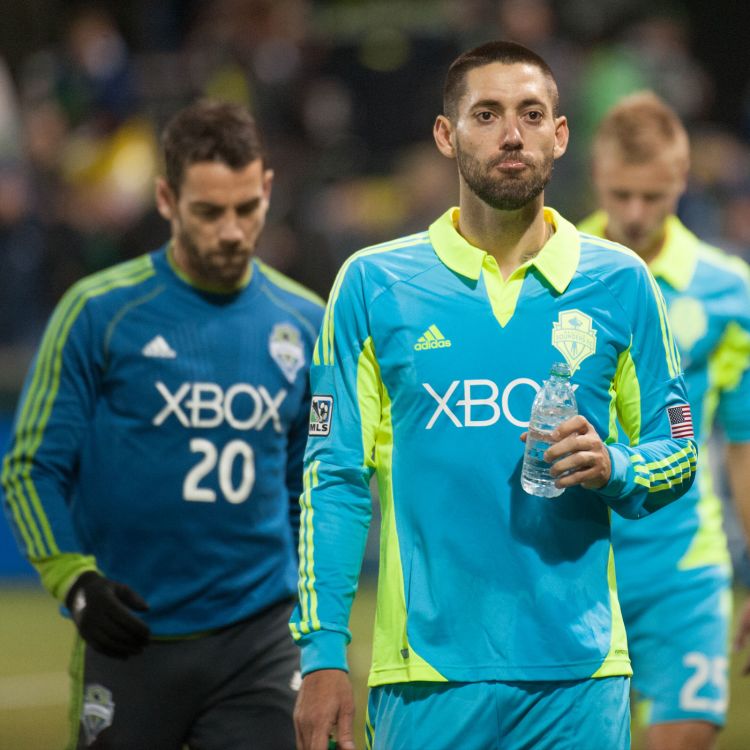
Clint Dempsey and the Sounders fall to Portland 5-3 on aggregate
November 2013
TIMBERS OUST SOUNDERS IN FIRST MLS PLAYOFF SERIES
History was on the Seattle Sounders’ side heading into the first leg of the 2013 MLS Cup Playoffs. They were hosting bitter rivals the Portland Timbers, a team that came up to Seattle having never even led at CenturyLink Field, let alone earn a victory.
But that changed swiftly and dramatically on Nov. 2, 2013, when Ryan Johnson put the visitors ahead in the 15th minute and staked them to a lead they would never relinquish. Darlington Nagbe doubled the advantage in the 67th minute, silencing a raucous crowd of over 38,000 fans. Osvaldo Alonso pulled one back for the Sounders in the 90th minute off a beautiful volley from 12 yards out, giving Seattle a lifeline for the return leg at JELD-WEN Field, but Portland had all the momentum after earning one of the best results in club history to date.
“They kicked our ass. Up here and down there.”
“I thought from the run of play we did enough to deserve a result, but our finishing wasn’t as sharp as Portland’s,” said former Head Coach Sigi Schmid. “Our finishing needed to be a little bit better.”
Clint Dempsey had a game-high six shots, but was unlucky not to find the back of the net. He had two dangerous free kicks in the first half that almost snuck past goalkeeper Donovan Ricketts and then had another opportunity in the 75th minute that just skipped wide of the post.
“I had my chances,” said Dempsey. “I was happy with the looks that I got and getting touches with the ball. It was just one of those nights that it wasn’t going to go in for me.”
Alonso’s goal at the end of the first leg gave the Sounders life, but any hope of a comeback was quickly squashed in the second leg. Portland extended its aggregate advantage to 4-1 in the first half off goals from Will Johnson and Diego Valeri.
Lamar Neagle, who was suspended for the second leg on yellow card accumulation, was in Portland watching in the press box and remembered his feelings vividly.
“It was frustrating to end my season one game early,” said Neagle. “Watching from above, I remember being devastated with how the game was going. We had a good team that year, that was one of the best teams I’ve been on.”
Futty Danso iced the series with a headed goal just after halftime. A couple of late Sounders strikes from DeAndre Yedlin and Eddie Johnson were semantic as the Timbers advanced to face Real Salt Lake in the Western Conference Championship.
“They kicked our ass,” said Director of Goalkeeping Tom Dutra. “Clear and simple, up here and down there. The way they did it — that was the most disappointing for me.”
Added Neagle: “I felt a disappointment in myself for not being able to play in that game and obviously us [as a team] going out…It stings a little bit more. You don’t want to lose at all in the playoffs, but to go out to your rival from the ‘70s, that’s pretty devastating.”
April 5, 2014
DEMPSEY SCORES HAT TRICK IN EPIC COMEBACK
When the Sounders fell behind by two goals in the 57th minute to the Portland Timbers on April 5, 2014, it was pretty determined how the rest of the game would play out. Over the previous five seasons — a stretch of 166 MLS matches — the Sounders had never recovered from a multi-goal deficit.
Surely, the Sounders wouldn’t be able to play escape artists in the final 30 minutes as the visitor in the league’s most fierce rivalry, right?
Wrong. And for that, you can thank Clint Dempsey.
Dempsey’s hat trick, which included two goals in the final five minutes, gave the Sounders a stunning road point at Providence Park. The 4-4 score featured the most goals of any Sounders-Timbers match in the MLS era. It also snapped the aforementioned streak of the Rave Green’s inability to come back from multi-goal deficits.
It was a match that had it all. “All the stars are out…” echoed John Strong at the beginning of the broadcast on NBC Sports, referring to both sides playing at full strength.
Emotions were running high, too. Just five months earlier, the Timbers dismantled the Sounders in the MLS Cup Playoffs. The last time the Sounders were in Portland, their season ended in a 5-3 aggregate loss to their biggest rivals.
To make this particular matchup even more peculiar, former Sounders star Steve Zakuani was on the opposing bench for the first time. Zakuani, who played for Seattle from 2009-13 and is currently on the broadcast team, played for the Timbers in 2014 under his former college coach Caleb Porter.
“All week we had been looking forward to that game,” Zakuani said. “We hadn’t started well that season.”
Just three minutes after the opening whistle, Seattle’s Kenny Cooper, who previously played for Portland, put a shot past former Sounders goalkeeper Andrew Weber for the early 1-0 lead. By the 14th minute, Portland’s Diego Chara and Diego Valeri each added a goal of their own as the hosts gained a 2-1 advantage.
In the 24th minute, Seattle equalized on a goal from Dempsey, with Obafemi Martins and Ozzie Alonso earning assists. Up until this point, only one of the previous eight regular-season MLS meetings featured multiple goals from both teams. In the first half hour, there were already two apiece. The score would remain 2-2 at halftime.
Ten minutes into the second half, momentum shifted back to the Timbers. Portland’s Chara, a defensive midfielder, recorded his second goal of the afternoon in the 55th minute. Just two minutes later, the Timbers extended the lead to 4-2 with a curling right-footed shot from Maximiliano Urruti.
With the Sounders down by two goals on the road with 30 minutes left: Enter Deuce Almighty.
In the 85th minute, Dempsey combined with Martins and Lamar Neagle for his second goal of the match.
“HEREEEEEE THEY COME! It’s 4-3 with five minutes to go!” Strong bellowed on the broadcast.
“He came through that day. Dempsey is a big-time player.”
Could the Sounders close the gap before the final whistle?
Just one minute later, explosive fullback DeAndre Yedlin was hip-checked in the area while going after the ball and the referee whistled for a penalty kick. The crowd was stunned.
Amid a resounding chorus of nerve-wracked Timbers supporters, Dempsey stepped to the spot.
Weber jumped one way. Dempsey went the other.
In stunning fashion, Dempsey brought the Sounders level with the club’s fifth-ever hat trick, and the Sounders returned to Seattle with a point. It was, and remains to be, the best single-match performance in the MLS era of the league’s biggest rivalry.
“[Owner] Adrian [Hanauer] and I were upstairs in the box watching together, and you could just feel it, like what is happening,” said Vice President of Soccer & Sporting Director Chris Henderson. “He came through that day. Dempsey is a big-time player.”
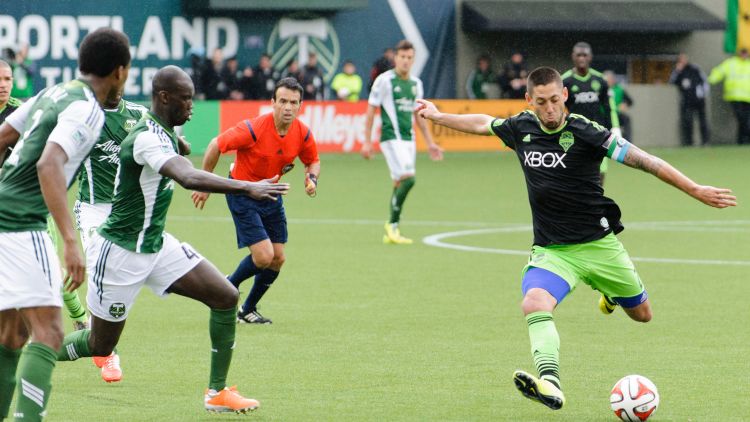

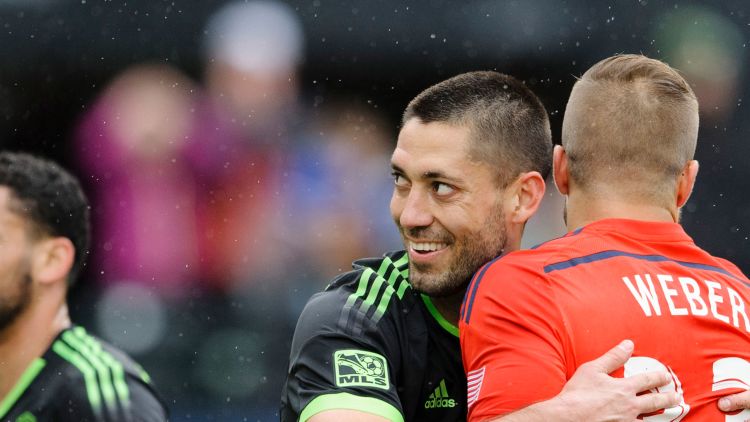
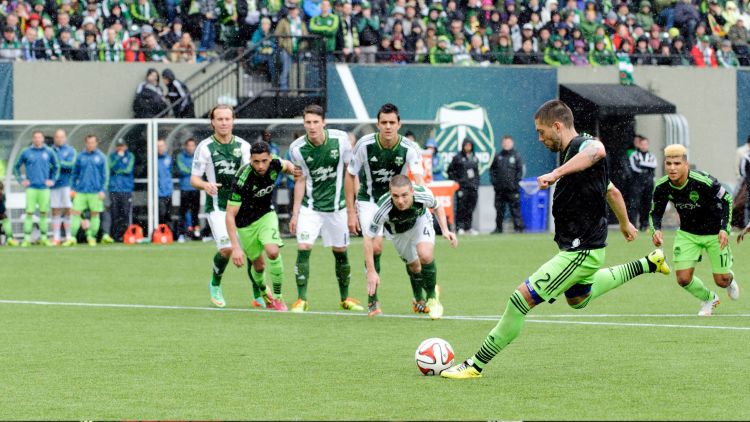
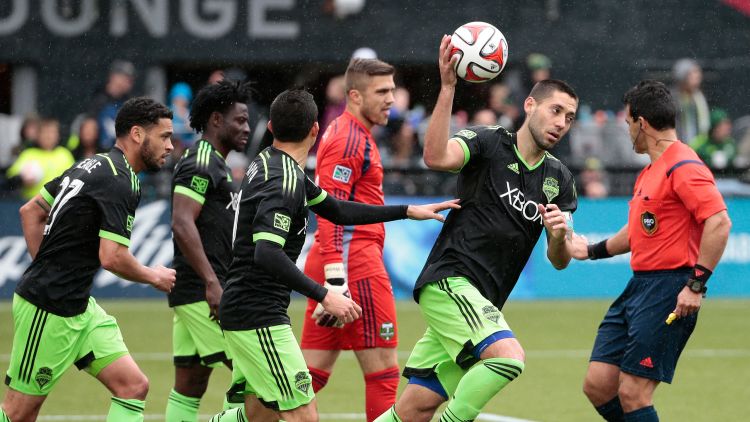
SUPPORTERS
CULTURE
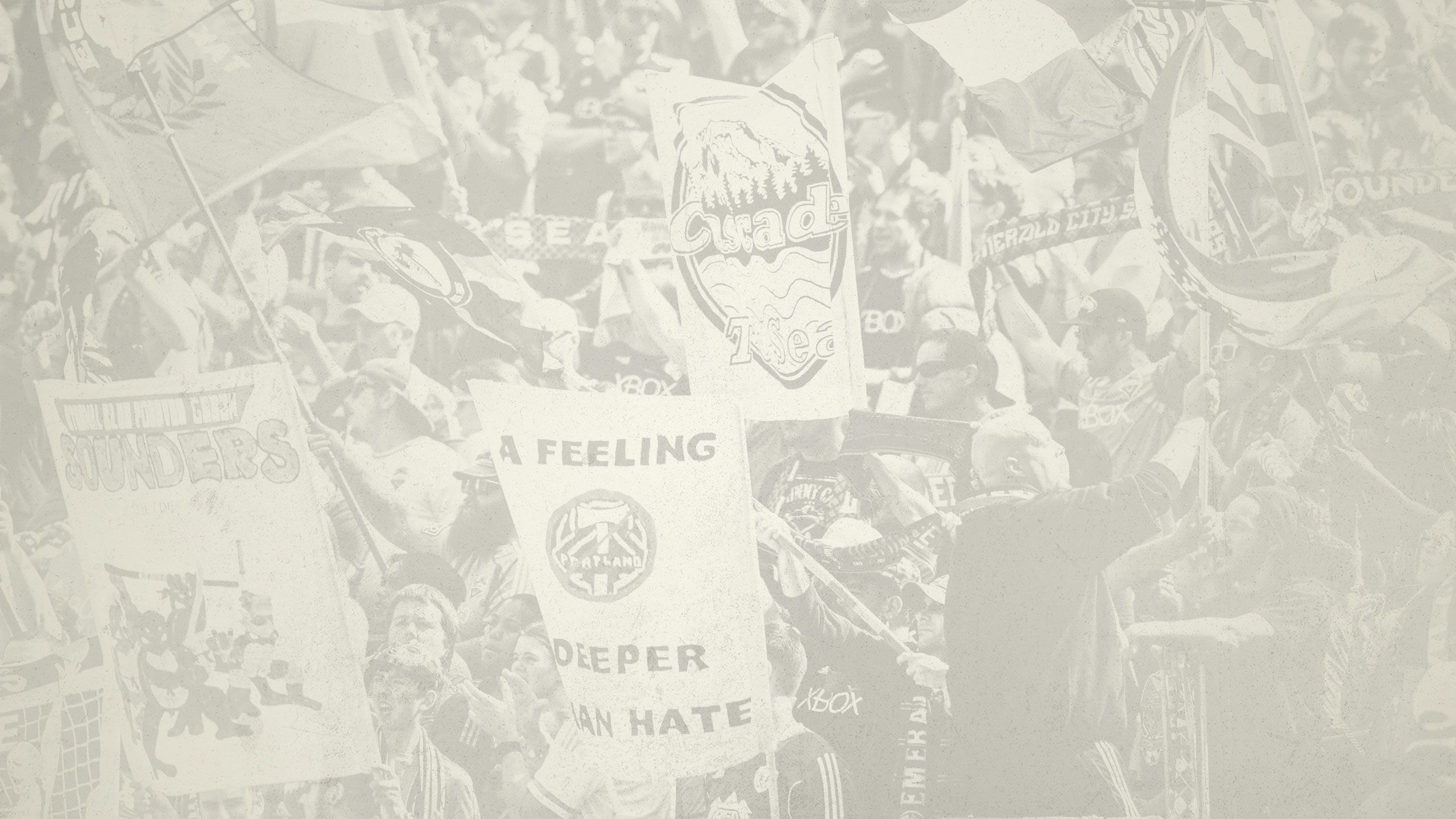
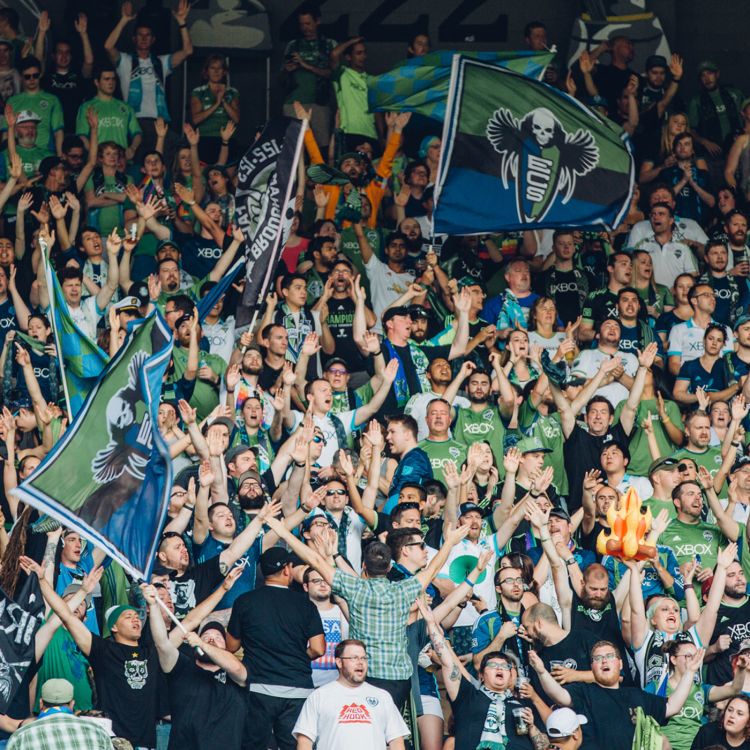
ECS during a Sounders match in Portland in 2017

ECS prior to a Sounders vs. Timbers match at Providence Park in 2017
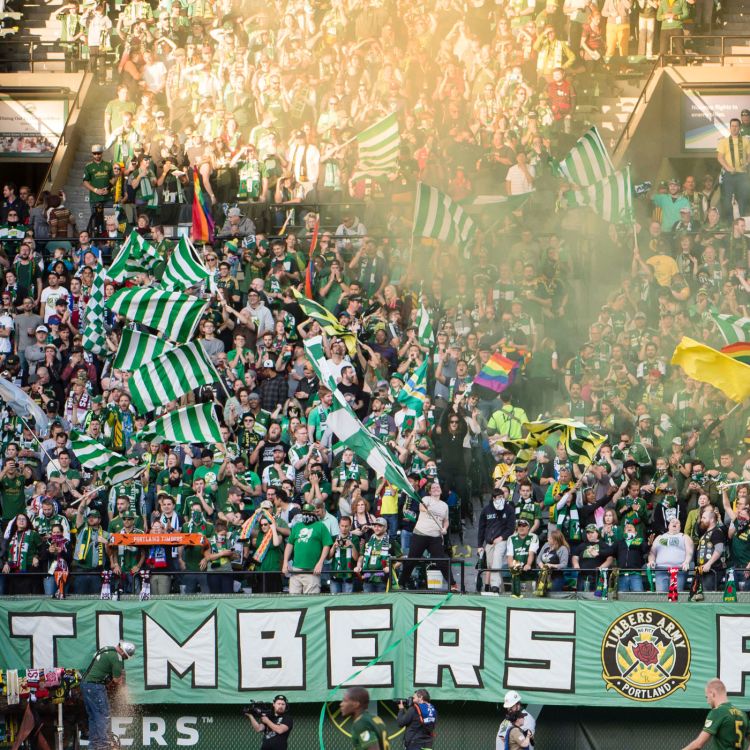
The Timbers Army in Portland during a match against Seattle
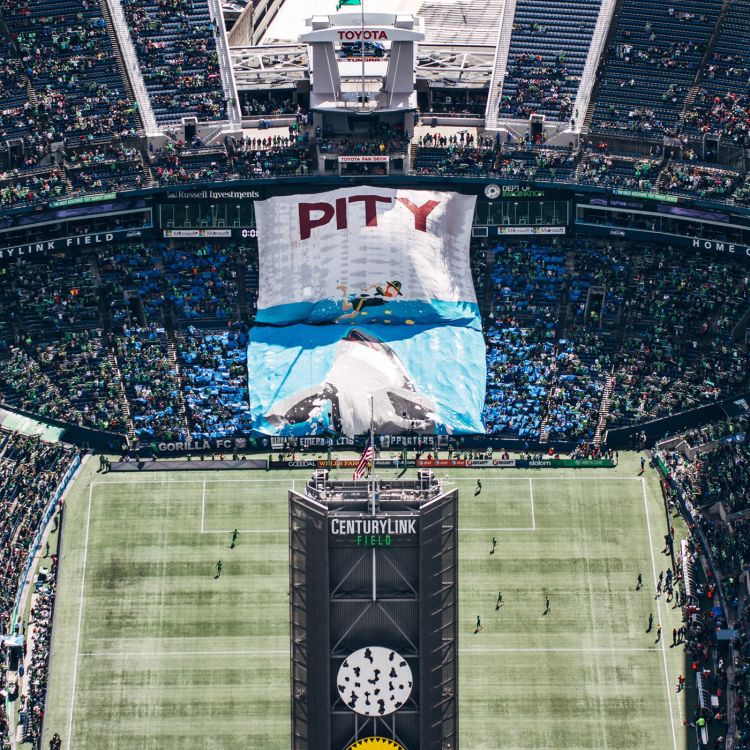
An ECS tifo in Seattle before a Timbers match in 2015

ECS flags fly at CenturyLink Field
“This rivalry extends beyond the pitch”
From a global perspective, it doesn’t quite fit that Seattle and Portland would be able to form a rivalry of much magnitude. Most of the game’s top rivalries feature two clubs within the same city, such as Celtic/Rangers in Glasgow, Scotland, or neighboring cities, like Manchester United/Liverpool, which are 35 miles apart.
Seattle and Portland are different. Nearly 200 miles across a state border gives the rivalry distance, yet that’s what makes it unique. The Seattle-Portland rivalry goes beyond two soccer clubs — it’s a city against a city.
“It’s about two cities; two different cities,” said Sounders Head Coach Brian Schmetzer, who grew up in Seattle, played for Seattle in the 1980s and ’90s, and has been a coach since 2002. “It’s not about the players on certain teams in certain eras, it’s about cities. It’s a true rivalry.”
“The players want to win every game because they are competitive and are wired that way. Fan bases want to be the better fan base.”
On the surface, the longevity of the rivalry seems to be its driving force of relevance. Spanning nearly 50 years of different teams, leagues and characters, no other soccer rivalry in the country compares. Yet, it’s much, much more. From the very beginning in 1975 — back when the Sounders were a second-year team in the North America Soccer League and the Timbers were in their inaugural campaign — the rivalry has existed.
“There’s no question that this is a real rivalry,” said Jimmy McAlister, who played for the Sounders from 1976-79. “It’s organic. It just grew out of the first year in Portland. It grew from there and it’s grown ever since.”
Truly, there has only been one thing that has existed from the very first meeting: the supporters.
“The rivalry is for the fans,” said S2 Assistant Coach Wade Webber, a Seattle native who has played and coached professionally in Seattle. “The players want to win every game because they are competitive and are wired that way. Fan bases want to be the better fan base.”
Since the 1970s, these two fan bases have prided themselves on besting the other. It is the supporters who create the buzz around the stadium and maintain the energy for the full 90 minutes. For as emotional and physical each Seattle-Portland match is on the field, the fans are the ones who magnify the rivalry in the stands.
“This rivalry extends beyond the pitch. It takes place between the fans,” said Steve Zakuani, who played for Seattle from 2009-13 and Portland in 2014. “Both fans unite, in one aspect, to prove this is the best rivalry in America. They do agree on that, but everything else they disagree.”
Perhaps the most visible example of this comes from tifo. Tifo is an Italian word that refers to the phenomenon of supporting a sports team, and this demonstration is shown in the form of large, choreographed displays that supporters groups unveil moments before a match.
In MLS, the Sounders and Timbers set the standard for tifo. Naturally, the supporter groups — Seattle’s Emerald City Supporters and Portland’s Timbers Army — save their best efforts for each other.
In 2011, Seattle welcomed Portland to MLS with a “Decades of Dominance” tifo that featured Sounders legends Jimmy Gabriel, Preston Burpo, Marcus Hahnemann, Fredy Montero and Roger Levesque. The next year, the “All In” tifo showed a detailed Sigi Schmid playing poker and it was named Tifo of the Year by MLSSoccer.com.
Another BEAUTIFUL tifo by @WeAreECS! Thanks for kicking off #SEAvPOR with this stunning display! 👌 https://t.co/ii1QAa6zPJ
— Seattle Sounders FC (@SoundersFC) August 30, 2015
“Build A Bonfire” became an instant classic in 2013 with the four horsemen — Eddie Johnson, Michael Gspurning, Ozzie Alonso and Brad Evans — setting the Brougham End ablaze. The next two years featured a dizzyingly colorful display called “Cascadian Colors,” followed by a Jaws-themed “Pity” tifo that had a shark nearly biting a Timbers-capped leprechaun.
In 2017, “The Rightful King” honored Schmetzer atop his Cascadia throne for his lifetime of service to the club.
Portland has had some epic ones, too.
“Walking in A Timbers Wonderland” and an Oz-inspired “There’s No Place Like Home” enchantingly covered their whole supporter section, while the nightmare-esque “Legends Never Sleep” featured a massive Freddy Krueger standing over the field.
“The fans have been huge in the rivalry and essentially embody not only what’s [happening] on the field, but also the rivalry between the two cities,” Levesque said. “You have Seattle as the big brother and Portland always trying to catch up. That’s played out on the field, but also in the interaction of the Timbers Army, the Emerald City Supporters and the back and forth between the two.”
The story continues
Don’t miss match 100 in Portland as 43 years culminates into one special moment. Then the rivalry comes home on Saturday, June 30, at CenturyLink Field when we kick off the next 100.
Thanks to everyone who contributed to this story:
- Grant Clark, Team Administration Director
- Clint Dempsey, Forward, 2013 - Present
- Tom Dutra, Club Director of Goalkeeping
- Pepe Fernández, Forward, 1974-76 & 1981-82
- Dave Gillett, Defender, 1974-79
- Taylor Graham, Defender, 2005 & 2007-08 & 2009-11
- Tim Haag, Public Relations Director, 1974-77
- Marcus Hahnemann, Goalkeeper, 1994-96 & 2012-14
- Chris Henderson, Vice President of Soccer & Sporting Director
- Danny Jackson, Defender, 2003-08
- Nate Jaqua, Forward, 2009-11
- Kasey Keller, Goalkeeper, 2009-11
- Roger Levesque, Forward, 2003-12
- Jimmy McAlister, Defender, 1976-79
- Lamar Neagle, Midfielder, 2009 & 2011 & 2013-15 & 2017 - Present
- Darren Sawatzky, Forward, 2000 & 2002-04
- Brian Schmetzer, Head Coach
- Wade Webber, S2 Assistant Coach
- Steve Zakuani, Forward, 2009-13
Photo Credits: Scott Bales/YCJ, Mike Fiechtner, Jane Gershovich, Rod Mar, Frank McDonald, Dan Poss, Corky Trewin, Charis Wilson.
